Battlefield Europe - Breaking the Yoke of Colonialism II
Moderators: Slitherine Core, Panzer Corps Design, Panzer Corps Moderators
Battlefield Europe - Breaking the Yoke of Colonialism II
Introduction
With the sudden change in the German leadership, the new German War Council has reassessed its priorities with respect to the war, the ultimate object of which is to now free all occupied countries from colonial rule. As the main aggressor and enslaver of other nations, both historically and culturally, the British have refined colonialism to an art form. Therefore it will be necessary to liberate the occupied nations currently under British control. In this way it is hoped that the British populace will see the futility of colonialism and revert to a more inward looking, passive government.
High Command has therefore set the main goal of the war as the total expulsion of all British forces from occupied territories. In order to achieve this and given the realities of distance, we envisage that by destroying all British Commonwealth forces in the North Africa and Middle East theatres, it will act as a catalyst for other Commonwealth countries in far away theatres (such as Asia) to overthrow their British oppressors without the need to bring significant German arms to bear in those theatres.
At the same time, however, we cannot forget the red threat that sits at Germany’s doorstep. Perhaps inspired by the British, the Russians have also shown their expansionist policies by occupying several nations on Germany’s borders. We will therefore set out to liberate the occupied nations of Eastern Europe so as to free them from Russian oppression. We believe that once Russian forces are restricted to their homeland territories, we can eventually come to an agreement with Russia to peacefully coexist with her neighbors without the threat of expansionism. German High Command have therefore set the secondary goal of the war as the liberation of all Russian occupied territories in Eastern Europe and the Caucuses, consisting of:
- Estonia
- Latvia
- Lithuania
- Belorussia
- Ukraine
- Armenia
- Azerbaijan
- Georgia
Onward to victory and the freedom of all oppressed peoples!
With the sudden change in the German leadership, the new German War Council has reassessed its priorities with respect to the war, the ultimate object of which is to now free all occupied countries from colonial rule. As the main aggressor and enslaver of other nations, both historically and culturally, the British have refined colonialism to an art form. Therefore it will be necessary to liberate the occupied nations currently under British control. In this way it is hoped that the British populace will see the futility of colonialism and revert to a more inward looking, passive government.
High Command has therefore set the main goal of the war as the total expulsion of all British forces from occupied territories. In order to achieve this and given the realities of distance, we envisage that by destroying all British Commonwealth forces in the North Africa and Middle East theatres, it will act as a catalyst for other Commonwealth countries in far away theatres (such as Asia) to overthrow their British oppressors without the need to bring significant German arms to bear in those theatres.
At the same time, however, we cannot forget the red threat that sits at Germany’s doorstep. Perhaps inspired by the British, the Russians have also shown their expansionist policies by occupying several nations on Germany’s borders. We will therefore set out to liberate the occupied nations of Eastern Europe so as to free them from Russian oppression. We believe that once Russian forces are restricted to their homeland territories, we can eventually come to an agreement with Russia to peacefully coexist with her neighbors without the threat of expansionism. German High Command have therefore set the secondary goal of the war as the liberation of all Russian occupied territories in Eastern Europe and the Caucuses, consisting of:
- Estonia
- Latvia
- Lithuania
- Belorussia
- Ukraine
- Armenia
- Azerbaijan
- Georgia
Onward to victory and the freedom of all oppressed peoples!
Prologue
I previously started an AAR here but was forced to stop at around turn 20 due to my pc dying http://www.slitherine.com/forum/viewtop ... 45&t=73078
On purchasing another pc I have decided to start up a new AAR based on the old plan with slightly revised goals. The main changes from the previous AAR are:
- I will not try and conquer Great Britain this time, instead focusing on liberating and holding occupied territories only (this should make the game easier early on, but a LOT harder later on).
- I will take a more flexible approach regarding the Russian border. In the prior AAR I stuck rigidly to the actual borders, but I have decided to take a more pragmatic approach this time and cede territory here/annex territory there, based on a defensible position (Viipuri and Nava will likely be ceded to the Russians, whilst I will probably take a couple of Russian cities such as Rostov and Belgorod and perhaps Smolensk).
- I will perform an amphibious landing on the Syrian coast
- This time I will start at Barbarossa and not play through the earlier scenarios (meaning I will have less prestige and troops).
- This time I’m playing on v1.8 instead of previously playing on v1.6.
On purchasing another pc I have decided to start up a new AAR based on the old plan with slightly revised goals. The main changes from the previous AAR are:
- I will not try and conquer Great Britain this time, instead focusing on liberating and holding occupied territories only (this should make the game easier early on, but a LOT harder later on).
- I will take a more flexible approach regarding the Russian border. In the prior AAR I stuck rigidly to the actual borders, but I have decided to take a more pragmatic approach this time and cede territory here/annex territory there, based on a defensible position (Viipuri and Nava will likely be ceded to the Russians, whilst I will probably take a couple of Russian cities such as Rostov and Belgorod and perhaps Smolensk).
- I will perform an amphibious landing on the Syrian coast
- This time I will start at Barbarossa and not play through the earlier scenarios (meaning I will have less prestige and troops).
- This time I’m playing on v1.8 instead of previously playing on v1.6.
The plan - 1941

Axis long-term war objectives. It is envisaged that on liberating all occupied countries and demonstrating that we are willing to defend them, the Allies will eventually abandon their colonialist expansion policies and enter into a peace treaty based on existing borders.
1. Almost all forces (including Luftwaffe units) in Western Europe will be transferred to other sections – either the East or the Med. The inferior non-German troops will be gradually rotated out of the front line and be relegated to partisan hunting and occupation duties, freeing up our stronger troops to focus on liberating the occupied nations.
2. Kriegsmarine to transfer all forces to assist in the liberation of Iceland and to then maintain position off the coast of Iceland to defend against any efforts to retake it. No major repairs will be performed on our vessels as high command have prioritized land forces and are willing to cede the Atlantic to the Allies. U-boats, however, will be used to harass the shipping lanes.
3. Mediterranean – Regia Marina vessels to be fully repaired and upgraded ready for action. They will then sally out in force and destroy all Allied naval units in the Med. Rommel’s forces to siege and take Tobruk with the assistance of the Regia Marina and reinforcements from mainland Europe. Due to their inferiority vs Allied fighters, the Italian fighters will be transferred to Eastern Europe, where they should be on par with the Russian fighters. They will be replaced in the Med by Bf 109’s.
4. Eastern front - Our armies in the East will aggressively advance to take full advantage of the Russian’s lack of preparations. Focus will be placed on encircling Russian armies to force their surrender rather than assaulting them directly. We expect to quickly liberate Poland, Latvia, Estonia and Lithuania and push deep into Belarus and Ukraine. Some armored and infantry units will be transferred to the Mediterranean theatre.
December 1941
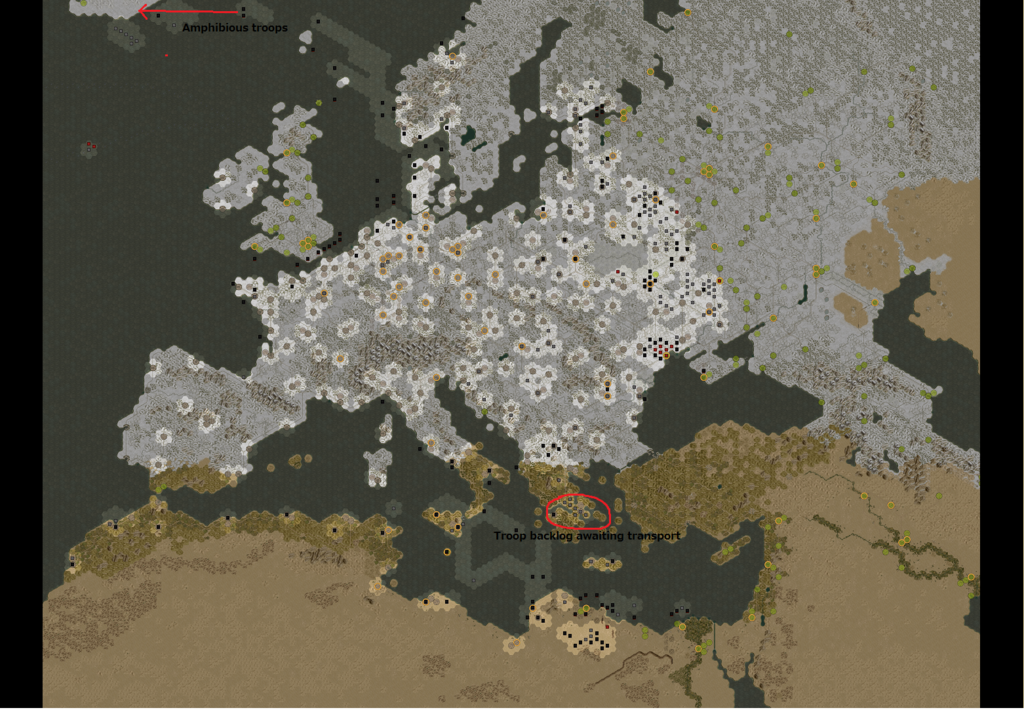
We have made strong advances in Eastern Europe, although progress on the Mediterranean front is slower than expected.
As winter sets in, our forces are warmed by the thought that in the short space of 6 months they have freed 5 countries (Belarus, Poland, Lithuania, Latvia and Estonia) from the bitter yoke of colonialism, with Ukraine also well on the way to total liberation.
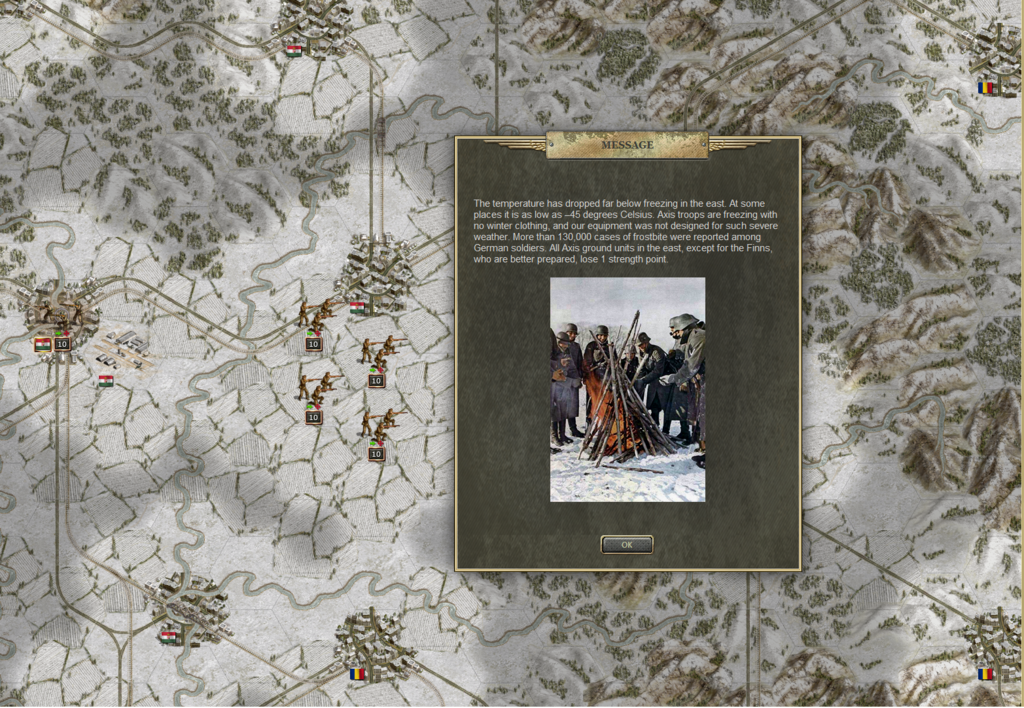
Our troops are poorly prepared for the bitterly cold winter.
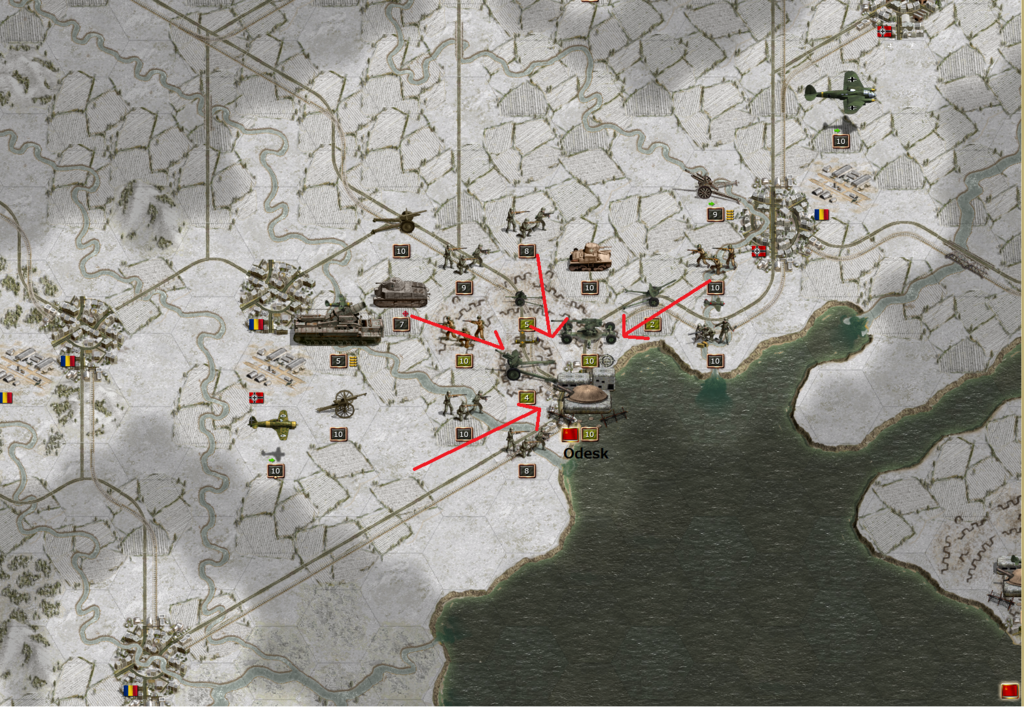
It is only a matter of time before Odesk falls, after which we will advance on the Crimean Peninsula.
We performed 2 major encirclements of Russian forces, resulting in the complete destruction of several Russian armies. On reaching the Russian border our forces are entrenching in preparation for expected counterattacks. We will employ a mix of static defence in easily defendable areas and elastic defence in the more open Russian Steppes. Having already reached the Russian border in the north and center, we are transferring forces further south to assist in liberating eastern Ukraine and the Crimean peninsula. Although our troops have been instructed to stop at the Russian border, a decision was made to advance on Smolensk and Pskov, given their strong defensible positions and operational airfields. We can cede this territory at a later date based on tactical position or in any future peace negotiations.
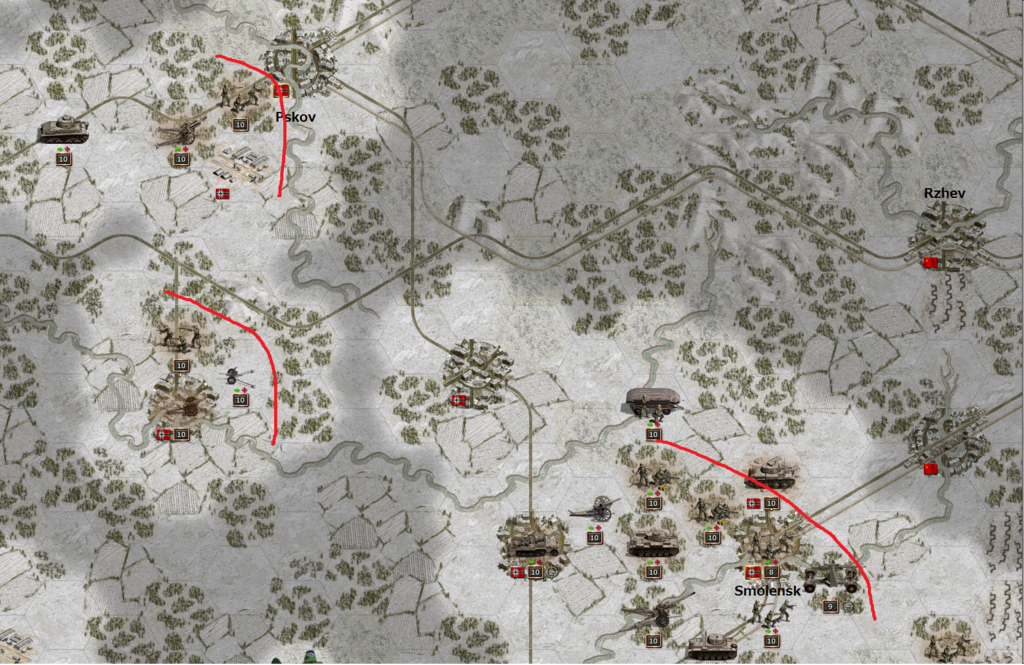
Army Group North have achieved their objectives and are now fortifying strong defensive positions in preparation for any Russian counterattack.
The Regia Marina, with heavy air support, have succeeded in reclaiming the Mediterranean, with only a few skulking submarines remaining, whilst the British capital ships are mostly confined to their ports in Egypt and Syria. Unfortunately the British submarines have taken their toll on our landing craft, fully destroying 2 flotillas whilst we were transferring troops to Africa. Although the loss of the relatively poorly skilled Italian troops will have little impact, it has seriously reduced the number of active transports – especially considering two flotillas are transporting troops to Iceland. Our planned amphibious landing on Cyprus has therefore been delayed to Spring of 1942. We will then use Cyprus as a jumping board to perform landings on Syria, before driving towards the oilfields of the far east. It is then intended that these forces will head north towards the oilfields of the caucuses. Given the lack of oil for our mechanized forces, it is imperative that we capture the oilfields both for our own use and to deny their use to the enemy.
In Libya, our forces destroyed all Allied units outside of Tobruk and began seiging it in earnest. However we were forced to abandon the siege as a result of the strong attacks during Operation Crusader. On first encountering the Allied attack our forces assumed a strong defensive position at the Halfaya Pass and further south. Supported by artillery and AA we managed to severely bloody several allied units, although our troops were still threatened, given our lack of medium armour. It was planned that in case of a possible breakthrough by the Allies or if threatened with being overwhelmed, we would perform an orderly retreat back to Benghazi. However, this contingency plan was put in doubt when the Allies caught us by surprise by bypassing our forces and heading east through Tobruk on the coastal road, then heading south west to cut off our forces. This threat will have to be addressed as the enemy forces now threaten our rear.
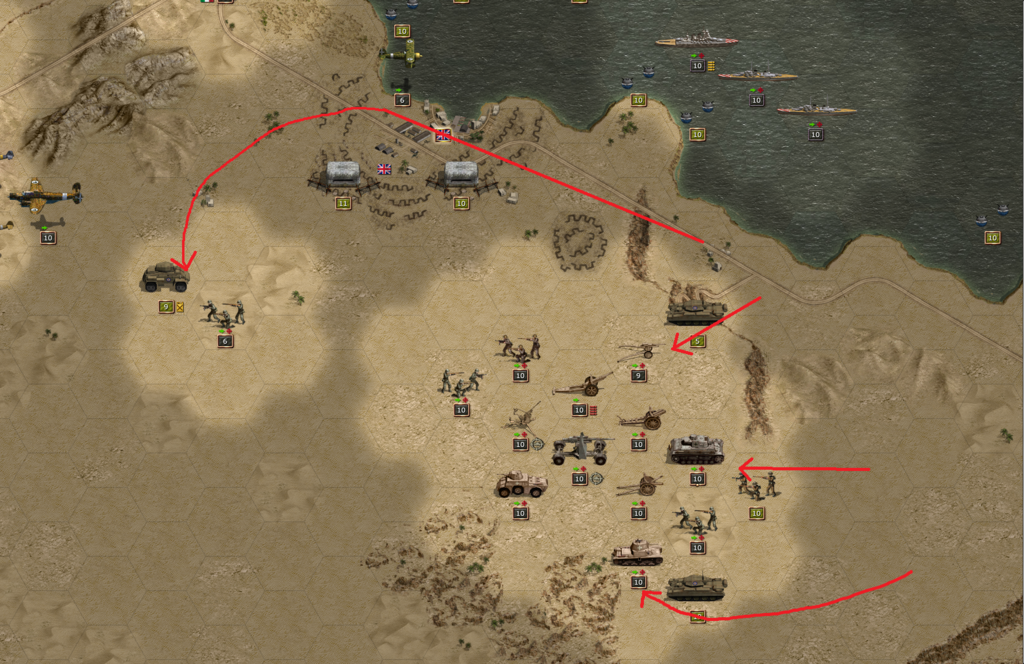
Our forces blunt the initial assault of Operation Crusader, however the Allies cleverly advance their light armour to block our supply lines.

With the battle turning in our favor, the Allies again cut off our supply lines, although this time with medium armour. However we now have sufficient forces to deal with such a threat and will soon concentrate on capturing Tobruk
The Luftwaffe have also commenced aerial bombing of Malta with the objective to capture the island by summer of 1942. This will further strengthen our position in the Mediterranean theatre.
The capital ships of the Kriesgmarine, escorted by destroyers, have managed to navigate the British minefields and Royal Navy patrols to reach the coast of Iceland, although we have lost 2 capital ships in the process. Taking advantage of the bad weather, they have commenced bombarding the long-range radar equipment stationed there and with 2 amphibious landing units on the way, the country will soon be liberated. We will then garrison a small force in Iceland, along with the majority of the Kriegsmarine, to help repel any attempted invasion. Our uboats meanwhile are harassing the Atlantic shipping lanes, although with limited success, given the large number of Allied ships patrolling the area. This has resulted in a very high attrition rate for our uboats.
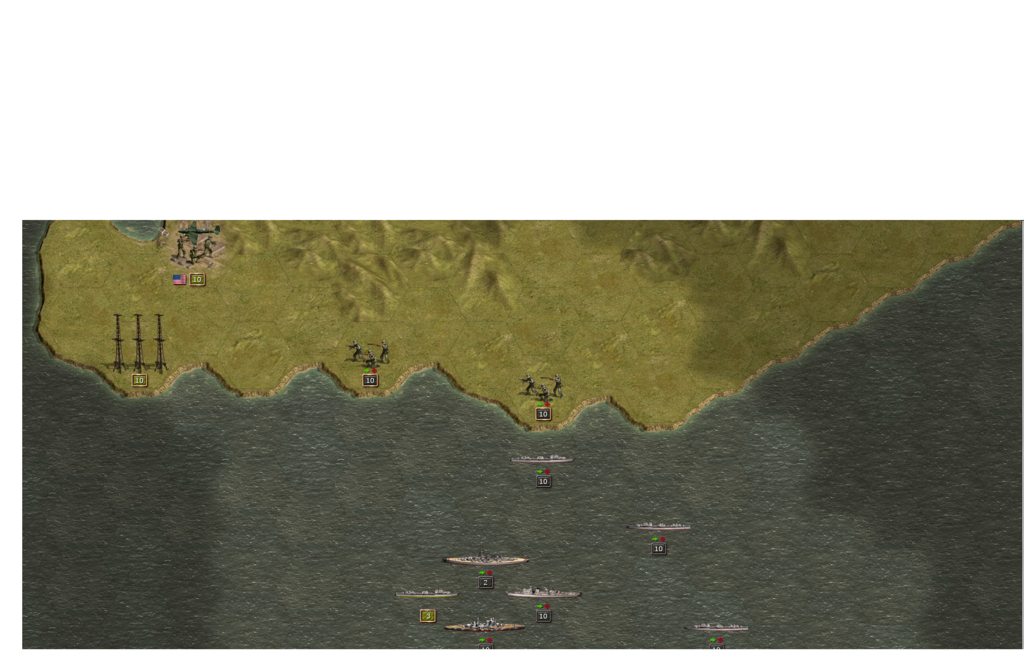
Most of our capital ships are severely damaged as no repairs were made on them before embarking to the Atlantic
We have left limited forces in Western Europe, consisting mostly of AA divisions to protect major cities. Only 1 squadron of FW 190’s remains to defend and is being used to target weakened Allied bomber squadrons. As a result, we are suffering intermittent declines in production due to Allied bomber raids. However as we are prioritizing other fronts, this is seen as a necessary evil.
Re: Battlefield Europe - Breaking the Yoke of Colonialism II
is this panzer corps?
Re: Battlefield Europe - Breaking the Yoke of Colonialism II
Haha, yes! Its a PzC mod of the European theatre made by McGuba. Its the best PzC mod i have ever played and i highly recommend it.AMDonline wrote:is this panzer corps?
viewtopic.php?f=147&t=47985
Summer 1942
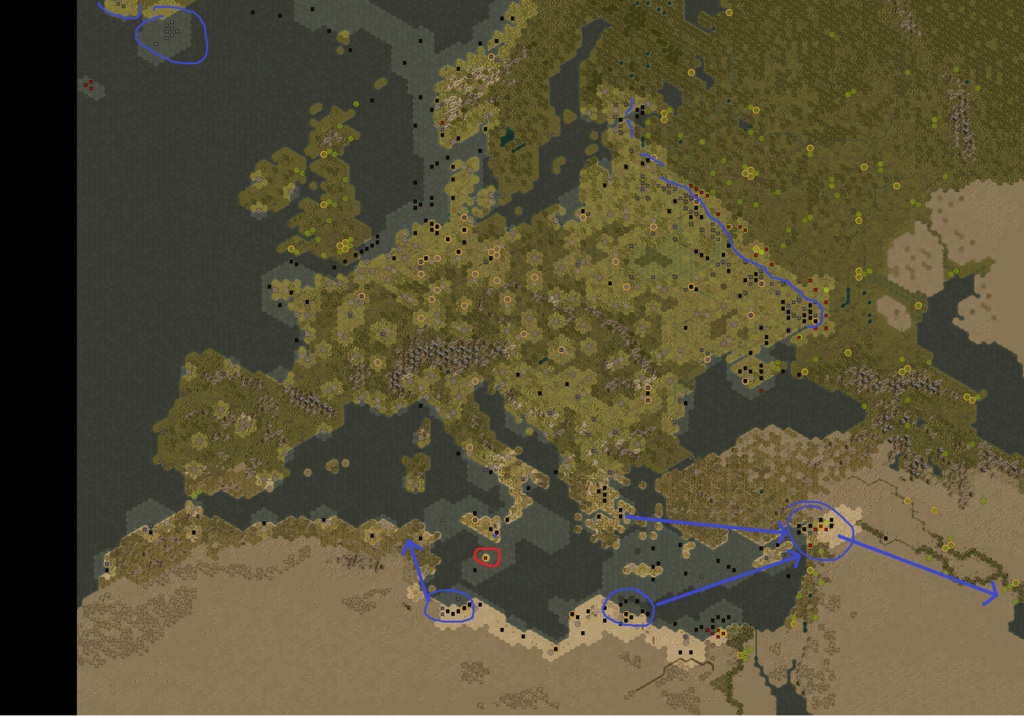
Late Summer ‘42
Having made excellent progress, all of Eastern Europe is now liberated from the Russian colonialists. We now only need to push the Russian forces out of Georgia, Armenia and Azerbaijan and then the Russians will be fully contained. Our forces in the East are repairing, refitting and upgrading in preparation for another expected strong winter assault by the Russians. We have invested significant resources into upgrading our forces wherever possible. Panzer 1’s and 2’s have now been phased out and replaced by Panzer III’s, whilst some of our fixed AT crew have been placed into the new Stug’s and Marder’s. The remainder of our AT crew have seen their guns upgraded to the new 7.5cm Pak, given the ineffectiveness of the 3.7cm and even 5cm Pak vs anything other than light armour. At significant cost, our Italian allies have also upgraded their fighter aircraft to the latest Folgore model, so as to be able to challenge the increasingly effective fighters being produced by the Russians. As a result, we have a thoroughly modern force with which to face the red threat. This has been necessary, as significant forces have been diverted to the Mediterranean theatre, leaving our forces in the East thinly stretched in terms of medium armour along some areas of the Russian border.
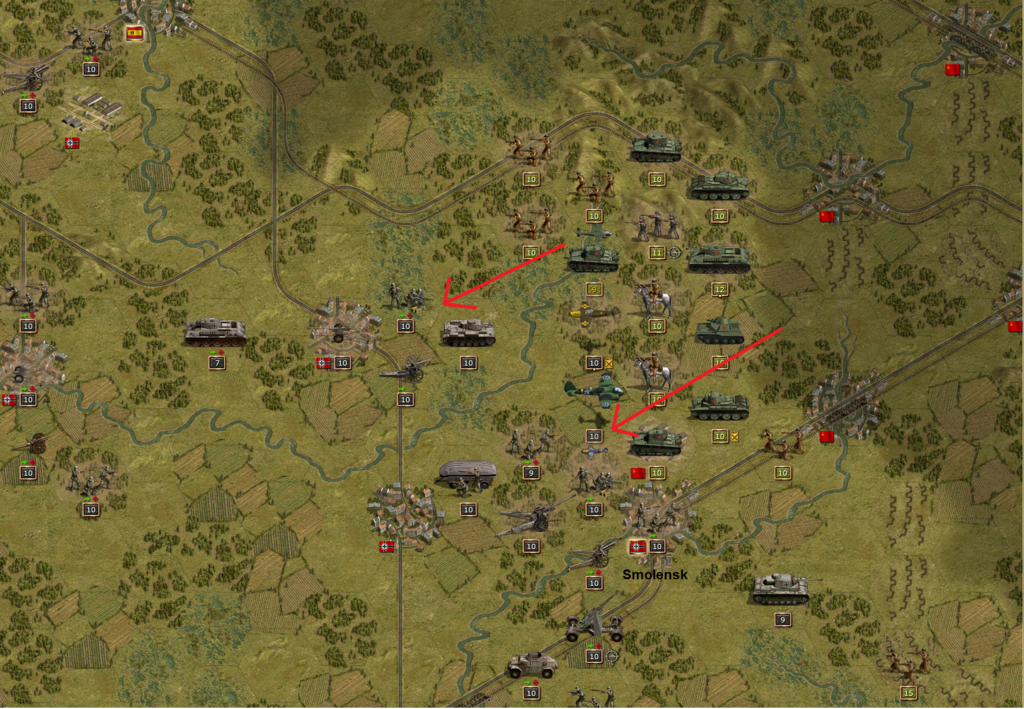
Significant Russian forces have massed north-east of Smolensk and are attacking our defensive positions around the city. However with strong artillery support and entrenched positions, their attacks have so far been fruitless
Although we have phased out our Panzer I’s and II’s for Panzer III’s, we still have a significant number of light tanks in the form of Panzer 35’s and Panzer 38’s. These divisions are currently stationed in reserve areas ready to lend assistance where needed, however they are rapidly becoming obsolete against anything other than infantry. High command is currently considering whether to invest the significant amounts required to upgrade these to Panzer III or Panzer IV variants. Although we have sufficient available resources considering the success of our forces to date (prestige in the low 5,000’s), it is an undeniable fact that the war will only get harder as time passes. Therefore it may be prudent to conserve our resources for the expected harder times to come. High command is thus split between proponents of upgrading our light armour to medium/heavy armour and those who prefer to use the light armour in an anti-infantry role and conserve resources for the future.

The obvious inferiority of the 35(t) and 38t(e) in comparison with the latest Pz III and IV’s can be seen. However is it worth the cost to upgrade to these tanks?
Given its critical position, a decision was made to advance on Rostov and after a short artillery duel, we captured the city and further firmed up our defenses. This position should be relatively easy to hold and will provide a buffer against any enemy forces advancing from the Caucuses. However the natural barrier of the river will disappear during winter when the river freezes over, therefore we may abandon it for a more defensible position at that time.
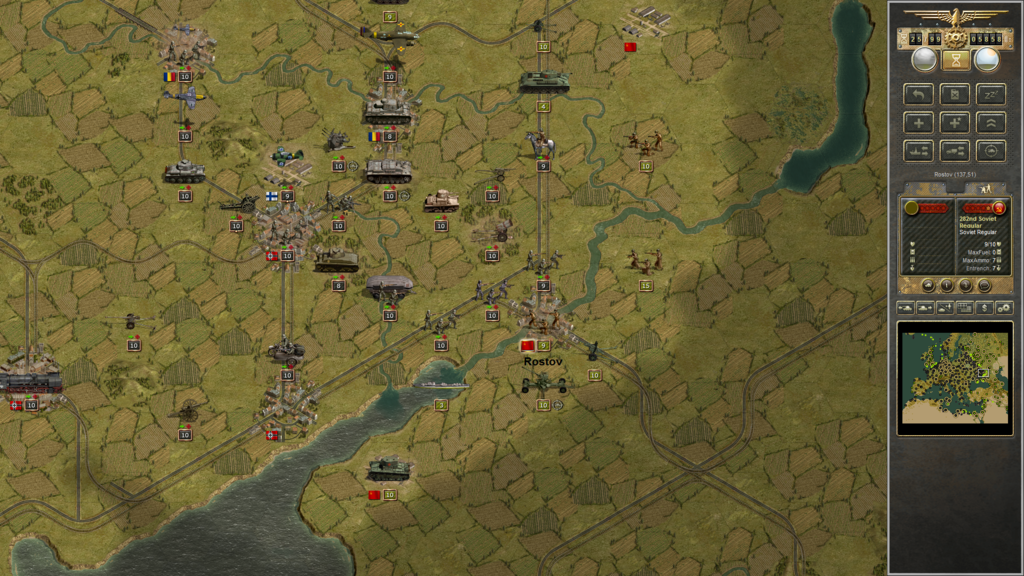
The natural barrier of the Don River forms an excellent defensive line
Our troops marched triumphantly through the city of Reykjavik, Iceland, after liberating the country from the American occupiers. With relatively few casualties sustained, morale was high amongst the German infantry, although there were mixed feelings amongst the troops about the expected long period that they would have to be stationed on the island, in case of American counter attacks.
Whilst our amphibious troops landed safely and were successful in defeating the US marines stationed in Iceland, the Kriegsmarine paid a high price, as Allied capital ships and destroyers tried to repel the attack. However it was on a strategic level that the most pain was felt, as the use of the 2 landing craft flotillas made them unavailable for the Mediterranean theatre. As well as the sinking of 2 landing craft flotillas by Allied subs in the Mediterranean, it has put heavy pressure on our logistical capability for landings performed on the Syrian coast, which have been pushed back several months. Due to lack of available marine fuel, our capital ships are now stranded off the coast of Iceland, where they can do little more than provide supporting barrage fire against any Allied forces that come within range. They are also severely damaged, limiting their usefulness. As a result, we will rely on u-boats (of which 2 wolf-packs are stationed off Iceland) and our Condor Squadron to repel any potential American assault.
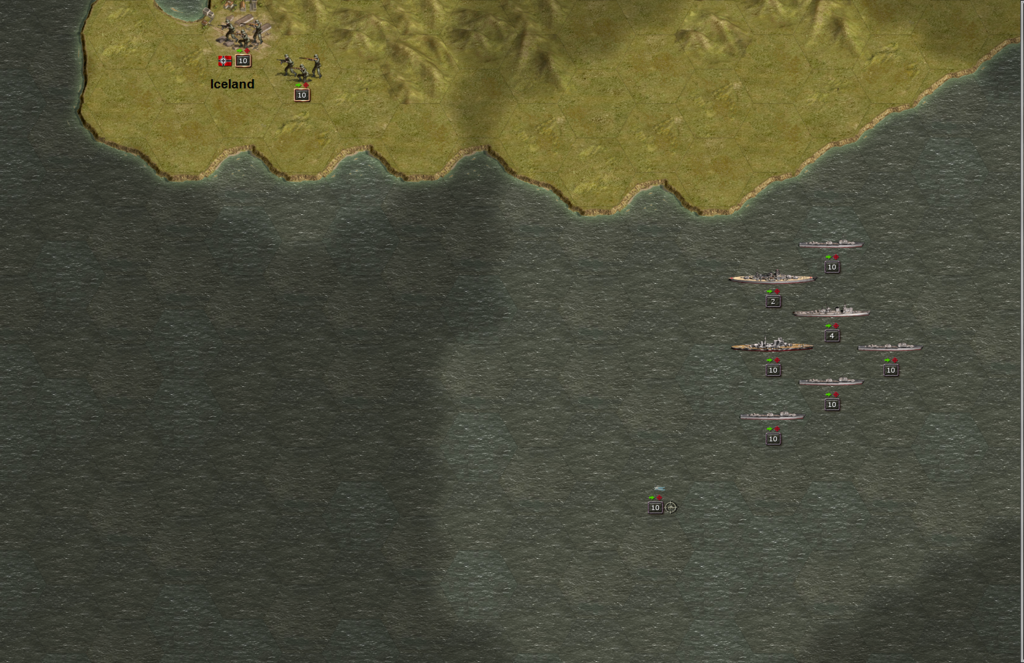
The Kriegsmarine lurk off the coast of Iceland ready to intercept any potential invasion forces
In the Mediterranean, our forces have scored several fantastic victories. The Brandenburgers managed to infiltrate Cyprus and capture the airfield, allowing Fallschirmjäger to land and consolidate it. A hard fight with occupying forces then ensued with both air and naval support provided by both sides. An amphibious landing by a Gebirgsjäger division proved the deciding factor and all allied troops on the island were either killed or captured. Both the Brandenburgers and Fallschirmjäger are now preparing to land behind enemy lines in Syria prior to an amphibious landing on the Syrian coast.
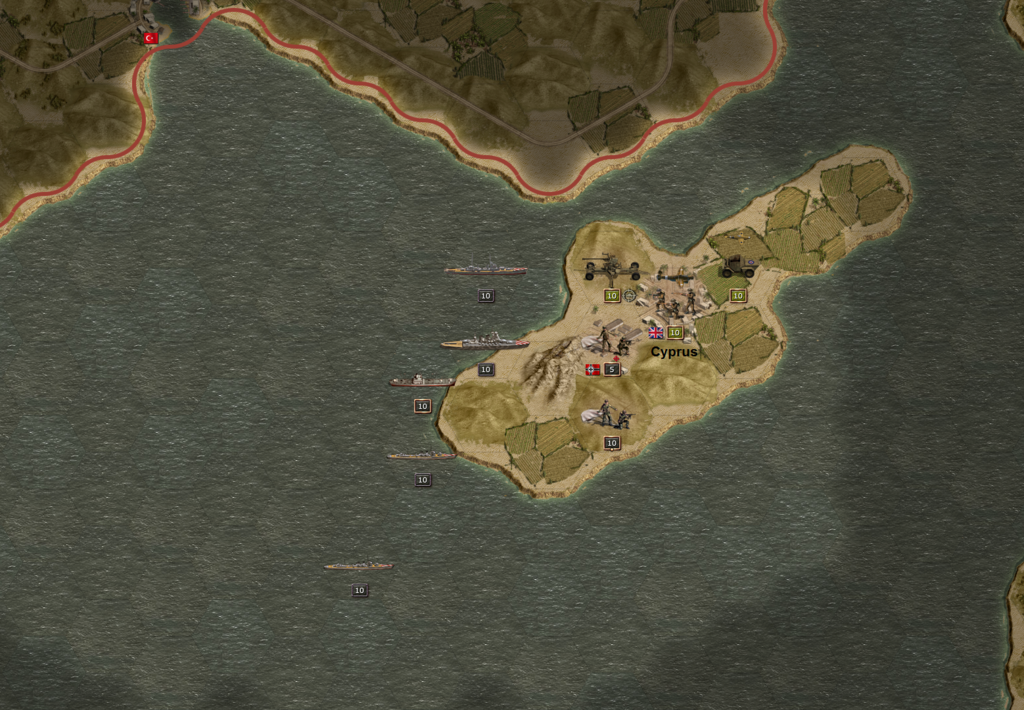
Learning from the mistakes of Crete, we successfully caught the defenders by surprise and captured Cyprus
The Luftwaffe, led by Hans Rudel, have managed to bomb Malta into submission and we will soon liberate the island from the Allies. It would have been liberated by now, however the British performed a suicide run by a tanker and air craft carrier which reinforced Malta with a fighter and tactical bomber squadron, thus delaying the liberation. With our air superiority in the region provided by Bf109’s and Folgore’s, we will soon remove this threat and liberate Malta. This will allow us to transfer the Luftwaffe to assist with the Syria landings. The capture of the airfield in Cyprus allows our forces to provide close air cover and we are optimistic about our ability to both create and maintain a beachhead until sufficient forces are transferred to commence a drive on the oil fields.
Meanwhile, our forces in Libya managed to destroy the Allied troops of Operation Crusader, re-encircle Tobruk and finally cause its surrender. The Pioniere division transferred from mainland Europe, backed by the firepower of our 8.8cm Flak division proved instrumental in destroying the perimeter defences and allowing our forces to overwhelm the defenders. We are now in the process of dividing our troops between 2 fronts – 1 group consisting of infantry, artillery, AA and 2 tank divisions is heading west in anticipation of a possible Allied landing in the direction of Tunis; whilst the other group consisting of mostly tanks, mechanized infantry and larger artillery pieces is heading to the Syrian Coast in preparation for an amphibious landing there.
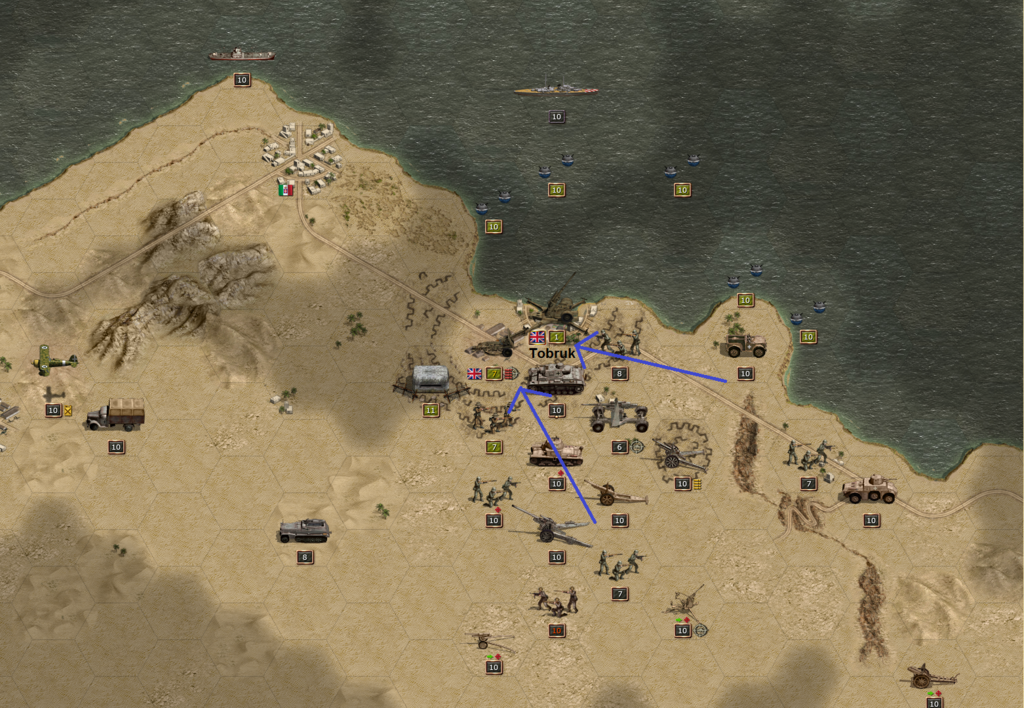
Surrender of Tobruk
With only 1 Focker squadron based in Western Europe it can honestly be said that the Allies have air supremacy. But it does not come without a cost to the Allies, as our massed AA slowly wears away at the enemy bombers and fighters. French resistance fighters are more a nuisance than a threat, but we have stationed several divisions of Romanian reserve troops in France to assist in dealing with them.
Our progress so far has surpassed our even our most optimistic general’s expectations, with victories on every front. Only the advance on the oilfields is behind schedule, but even that is proceeding well, with only limited casualties. The Russian forces have also been surprisingly passive, apart from around Smolensk where they have met with no success after facing our heavily entrenched positions. At this rate, high command are confident of conquering the middle eastern oilfields by late winter and commencing the final drive north to the oilfields of the Caucuses. The war will surely be over soon with the Allies seeing the hopelessness of continuing such a fruitless struggle.
-
GeneralWerner
- Staff Sergeant - Kavallerie

- Posts: 331
- Joined: Tue Apr 28, 2015 7:03 pm
Re: Battlefield Europe - Breaking the Yoke of Colonialism II
Hello JimmyC,
good luck for your game.
I look forward to see how you perform in Russia and Middle East. Especially in the east you will be hit by the full power of the Red Army winter attacks. Hope you can do it better than me. My first game with V1.8 with a Caucasus-first-strategy ended in a destroyed and defeated Berlin
GW
good luck for your game.
I look forward to see how you perform in Russia and Middle East. Especially in the east you will be hit by the full power of the Red Army winter attacks. Hope you can do it better than me. My first game with V1.8 with a Caucasus-first-strategy ended in a destroyed and defeated Berlin
GW
Re: Battlefield Europe - Breaking the Yoke of Colonialism II
I already found it harder than last version 1.6 that I played. So yes, I am interested to see if it is possible to withstand the Russian counter-attacks. Actually, I am quietly confident of being able to do this until Operation Neptune, but after the Allied landing, all bets are off.
Critical to my plan is taking and holding the oilfields. This will provide me with significant prestige which I can use to upgrade and reinforce my troops. So I suspect that the game will either be won or lost in the Middle East/Caucuses. At first I did not quite understand how critical this would be and almost restarted the game when I realized that transports lost are lost permanently. At the moment, the middle-east theatre is really in the balance...
Will hopefully provide another update tomorrow (I’ve progressed quite far, but its hard to find time to write up these AAR’s).
Critical to my plan is taking and holding the oilfields. This will provide me with significant prestige which I can use to upgrade and reinforce my troops. So I suspect that the game will either be won or lost in the Middle East/Caucuses. At first I did not quite understand how critical this would be and almost restarted the game when I realized that transports lost are lost permanently. At the moment, the middle-east theatre is really in the balance...
Will hopefully provide another update tomorrow (I’ve progressed quite far, but its hard to find time to write up these AAR’s).
Eastern Front
Heavy Russian counterattacks around Smolensk have been beaten back, with relatively minimal losses to our own troops who are heavily entrenched and strongly supported. The dense terrain, rivers and swamps greatly limit the effectiveness of the Russian armour in the region. Further south, we have strong defences at the main crossing west of Bryansk, but the Russians have been quiet in this sector.
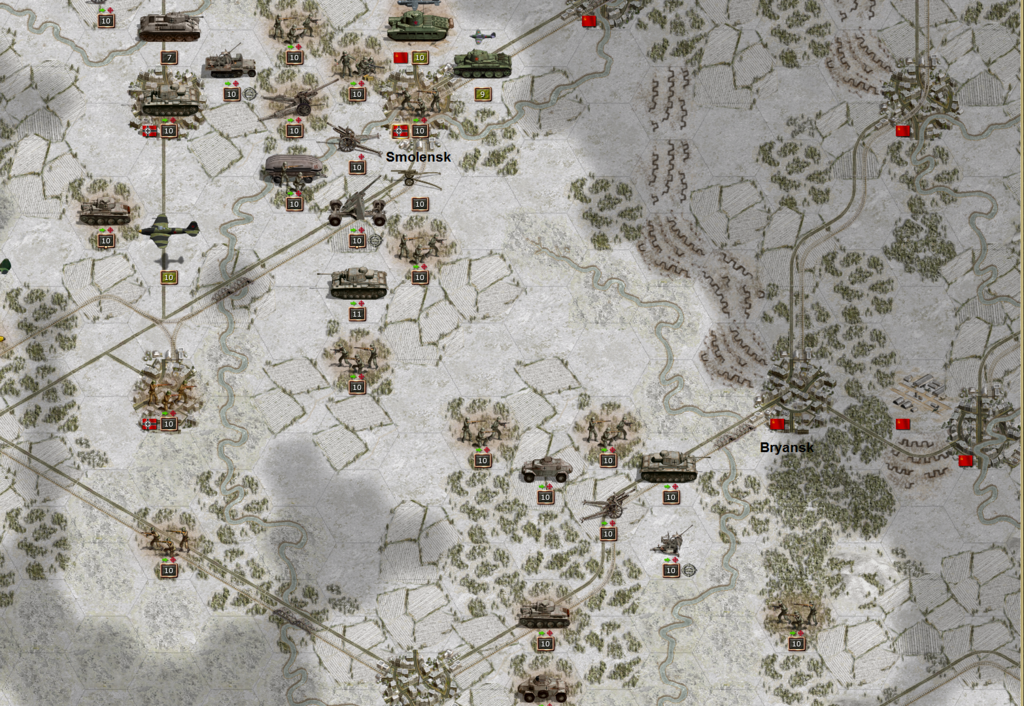
We are heavily entrenched on the northern front
There is also limited activity in the central sector. We concentrate our forces in 2 areas. South of Kursk around Begorod our infantry have had several months to entrench themselves into the city and nearby woods, with the intervening open ground being occupied by 7.5cm Pak 40 and backed up by artillery and AA. However with the river freezing over it exposed the right flank of our defences. Therefore a short withdrawal was performed to center our defenses around the city of Kharkov, where our defensive position is considered stronger.
To the west of Kursk we have anchored our defenses around the city of Konotop and adjacent swampland with screening forces in the forests to the north-east. Konotop has the benefit of lying on a major road and rail line and can therefore be speedily reinforced if necessary. However there is a large amount of flat, open terrain to the south, which will favor the Russians given their superiority in medium armour. If necessary, we may withdraw our forces in this area to the more easily defensible position of Kiev, although this would have the effect of forming a large salient splitting our forces in the north and south. Whilst expecting the Russian attack to fall in this direction, we have so far seen only light probes by enemy forces, with the main thrust falling much further south.
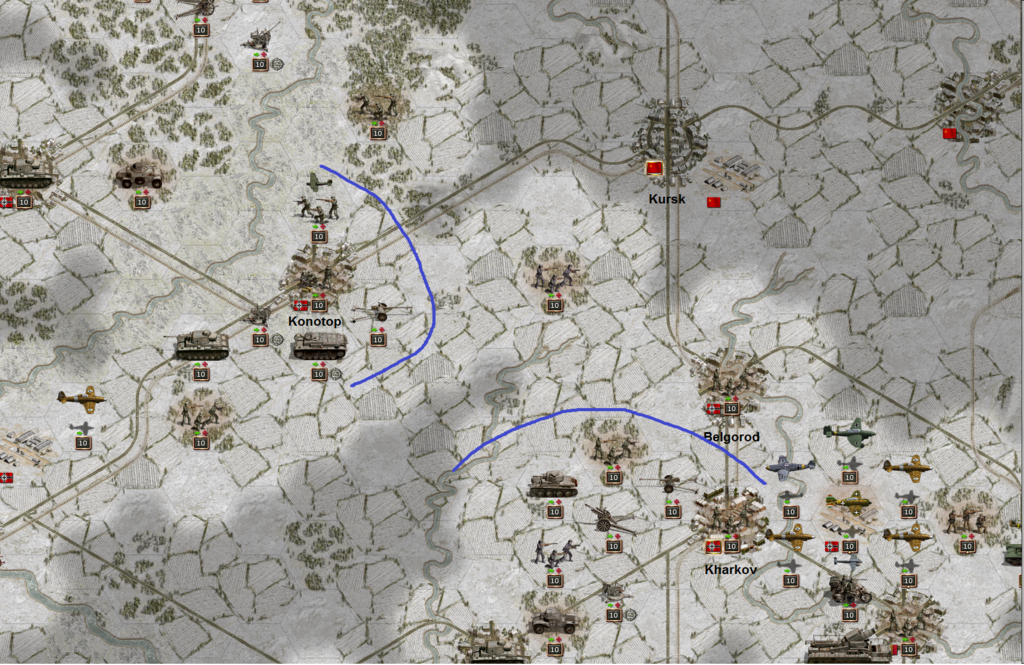
All quiet on the central front
The freezing over of the rivers has posed a more serious problem for our defences around Rostov, which relied heavily on them as a natural barrier. Months of entrenchment will have to be abandoned as we have to shift our forces to allow for the ease with which the Russians can now cross the river. Our defenses are now relatively firm consisting of infantry and light armour, backed by AA and significant artillery. We are only lacking in medium armour and are therefore somewhat susceptible should the Russians attack with significant armoured elements. In this case, we would have to rely on the Luftwaffe to provide close air support.
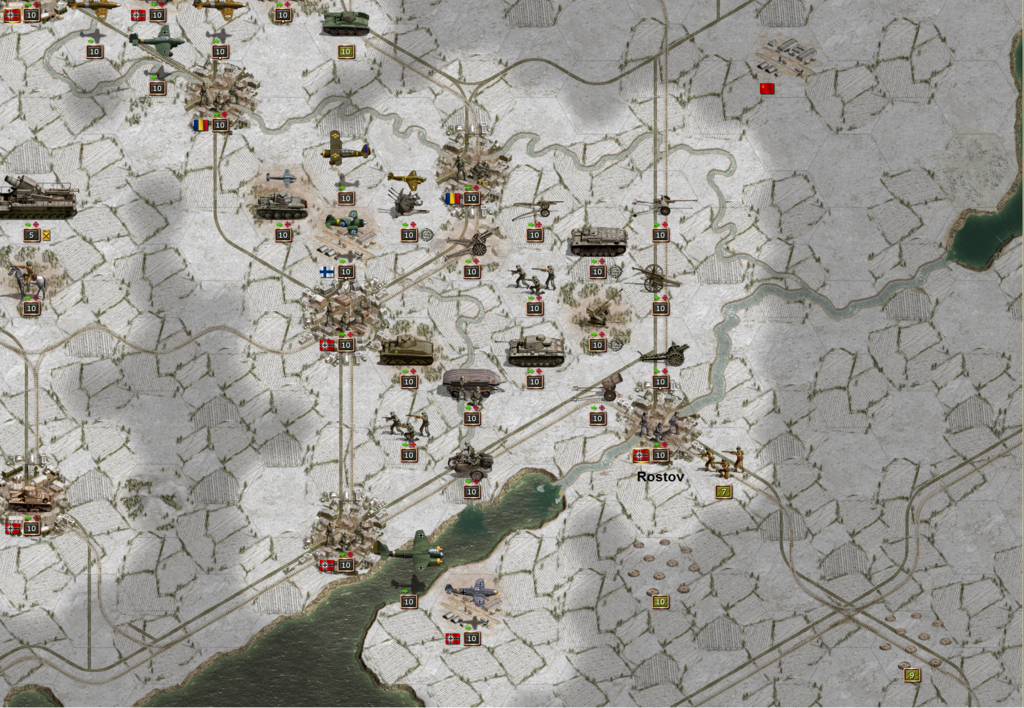
The freezing of the Don causes us to rethink our defensive positions
The Russians, perhaps relying on intelligence of our weakness in medium armour, have taken advantage of the frozen rivers to attack across the Don and Donets, targeting our AT defenses with their latest model T34’s. Given the weather, the Luftwaffe is unable to intervene and although our AT specializes in defending vs armour, the sheer number of attacking tank divisions has forced them to withdraw. With only 1 division of PzIII’s in the area, we must make a decision on whether to try and stand and fight, or else withdraw our units back to a more defensible line. A recently completed Tiger battalion and Stug IIIG battalion are now being transported to the area, ready to lend assistance, as even our most up to date PzIII tanks are at best an even match for the Russians T34’s and with the bad weather, the Luftwaffe are mostly impotent.
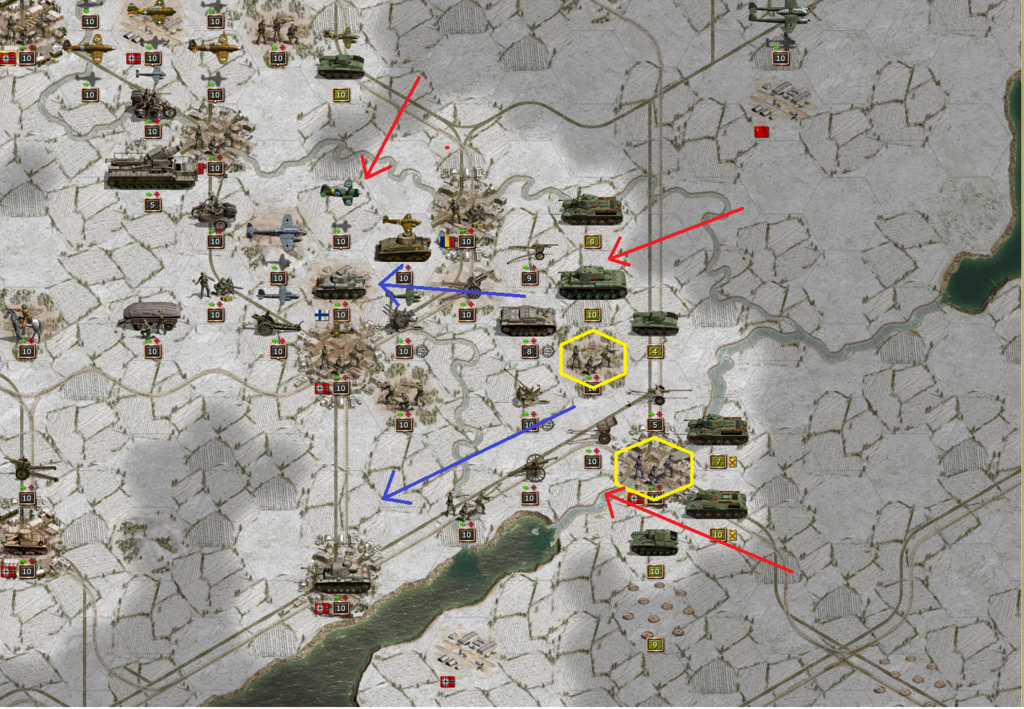
The Finnish troops garrisoning Rostov have been isolated and will likely be destroyed. Their sacrifice allowed our other troops to pull back and they will forever be remembered. The infantry garrisoning the forest to the North of Rostov was also in danger of being annihilated, but with assistance from artillery and a timely intervention by our PzIII division, were able to withdraw after being severely mauled.

We are heavily entrenched on the northern front
There is also limited activity in the central sector. We concentrate our forces in 2 areas. South of Kursk around Begorod our infantry have had several months to entrench themselves into the city and nearby woods, with the intervening open ground being occupied by 7.5cm Pak 40 and backed up by artillery and AA. However with the river freezing over it exposed the right flank of our defences. Therefore a short withdrawal was performed to center our defenses around the city of Kharkov, where our defensive position is considered stronger.
To the west of Kursk we have anchored our defenses around the city of Konotop and adjacent swampland with screening forces in the forests to the north-east. Konotop has the benefit of lying on a major road and rail line and can therefore be speedily reinforced if necessary. However there is a large amount of flat, open terrain to the south, which will favor the Russians given their superiority in medium armour. If necessary, we may withdraw our forces in this area to the more easily defensible position of Kiev, although this would have the effect of forming a large salient splitting our forces in the north and south. Whilst expecting the Russian attack to fall in this direction, we have so far seen only light probes by enemy forces, with the main thrust falling much further south.

All quiet on the central front
The freezing over of the rivers has posed a more serious problem for our defences around Rostov, which relied heavily on them as a natural barrier. Months of entrenchment will have to be abandoned as we have to shift our forces to allow for the ease with which the Russians can now cross the river. Our defenses are now relatively firm consisting of infantry and light armour, backed by AA and significant artillery. We are only lacking in medium armour and are therefore somewhat susceptible should the Russians attack with significant armoured elements. In this case, we would have to rely on the Luftwaffe to provide close air support.

The freezing of the Don causes us to rethink our defensive positions
The Russians, perhaps relying on intelligence of our weakness in medium armour, have taken advantage of the frozen rivers to attack across the Don and Donets, targeting our AT defenses with their latest model T34’s. Given the weather, the Luftwaffe is unable to intervene and although our AT specializes in defending vs armour, the sheer number of attacking tank divisions has forced them to withdraw. With only 1 division of PzIII’s in the area, we must make a decision on whether to try and stand and fight, or else withdraw our units back to a more defensible line. A recently completed Tiger battalion and Stug IIIG battalion are now being transported to the area, ready to lend assistance, as even our most up to date PzIII tanks are at best an even match for the Russians T34’s and with the bad weather, the Luftwaffe are mostly impotent.

The Finnish troops garrisoning Rostov have been isolated and will likely be destroyed. Their sacrifice allowed our other troops to pull back and they will forever be remembered. The infantry garrisoning the forest to the North of Rostov was also in danger of being annihilated, but with assistance from artillery and a timely intervention by our PzIII division, were able to withdraw after being severely mauled.
Operation Torch
The American's performed a landing on the north-west coast of Africa and are driving towards Tunis. Intelligence had indicated this could occur and we therefore were able to concentrate our forces around the border area, ready to reinforce Tunis. We have 3 panzer divisions consisting of PzIII, PzIV and Italian Fiat M13/40, as well as infantry, artillery, AT and AA. On their own, these forces are not considered enough to defeat the Americans. But with the support of the Regia Marina and Luftwaffe, we are hopeful of driving the Americans back into the sea. First, we will win the battle in the air, with our 3 Bf109’s, supported by AA resulting in air superiority and eventual air supremacy. Second, our medium and heavy bombers will significantly damage the American naval forces. Third, the Regia Marina will move in to finish the American naval threat, before turning their guns landward to provide fire support for our troops around Tunis. This should allow us to beat back and eventually destroy the American army.
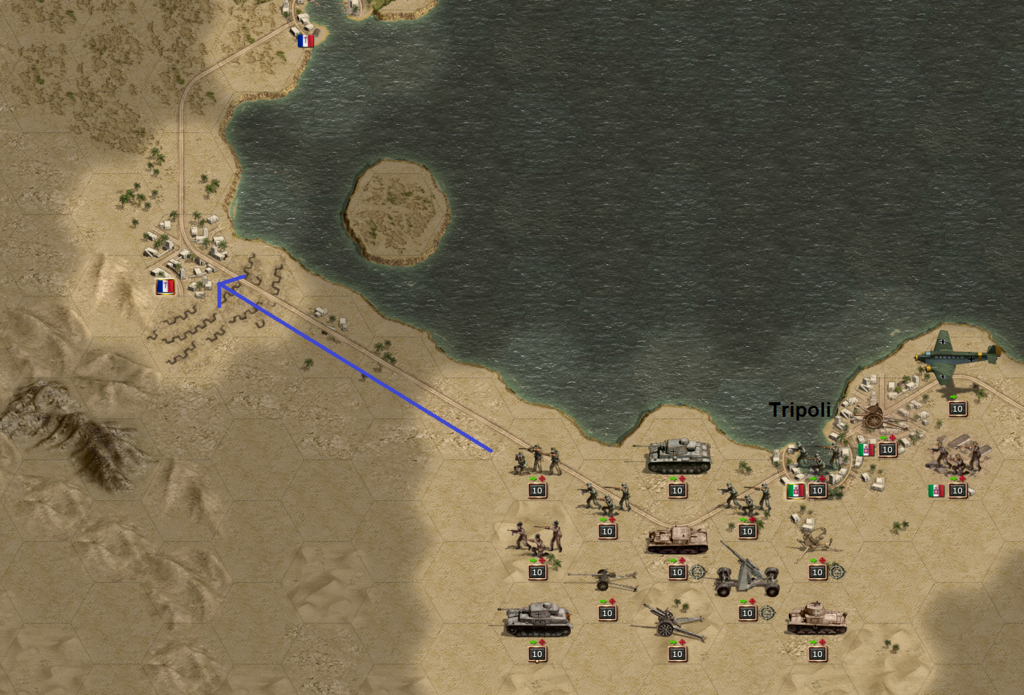
Our forces massed on the border and are now prepared to advance to counter the American invasion
Following a significant naval engagement south of Cyprus, approximately half the Regia Marina is in port undergoing repairs and will soon sally out to join the remainder of the fleet which is stationed off Sicily, ready to attack any destroyers or damaged capital ships that come within striking distance.
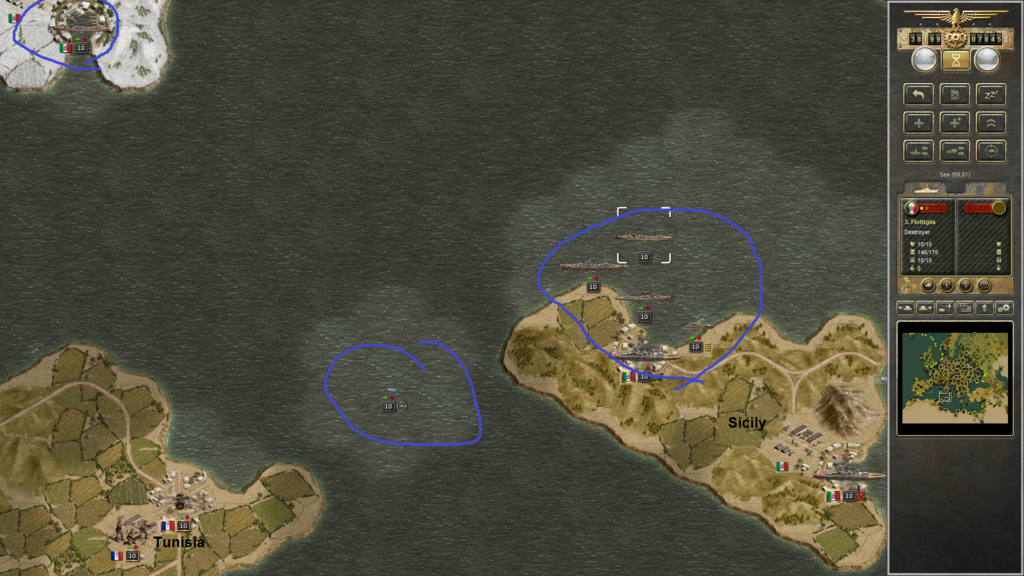
Only around half the Regia Marina are currently in position ready to intercept the American fleet supporting the Torch landings
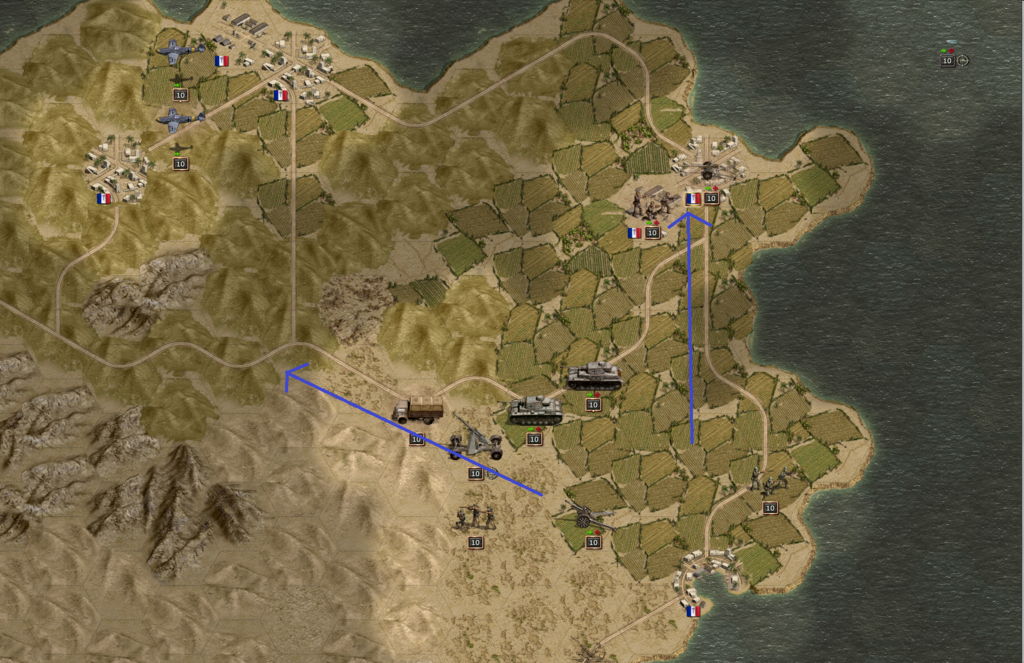
With the French resistance wilting, our forces rush up the coast towards Tunis and on the roads inland, ready to counter the American forces. Note the 2 Bf109 squadron’s performing reconnaissance further West. We have a total of 3 squadrons in the area, with a further squadron being transferred from the Eastern front.

Our forces massed on the border and are now prepared to advance to counter the American invasion
Following a significant naval engagement south of Cyprus, approximately half the Regia Marina is in port undergoing repairs and will soon sally out to join the remainder of the fleet which is stationed off Sicily, ready to attack any destroyers or damaged capital ships that come within striking distance.

Only around half the Regia Marina are currently in position ready to intercept the American fleet supporting the Torch landings

With the French resistance wilting, our forces rush up the coast towards Tunis and on the roads inland, ready to counter the American forces. Note the 2 Bf109 squadron’s performing reconnaissance further West. We have a total of 3 squadrons in the area, with a further squadron being transferred from the Eastern front.
Drive on the Oilfields
On the Syrian coast, our forces expanded on the initial beachhead, beat back a small counterattack by Allied forces, who were caught unawares, and captured the cities of Atakia and Aleppo, with its adjacent airfield. The Brandenburgers and Fallshminjaeger were instrumental in defeating the defenses centered around Aleppo, although sadly the Brandenburgers suffered so many casualties in the attack that they have been disbanded and their remaining troops integrated into other units. Whilst we landed significant armour and infantry on the Syrian coast, the lack of available transports delayed the arrival of artillery and AA support. Given the increasingly dire oil shortage being faced, we determined to commence advancing East towards the oilfields in advance of the artillery arriving.

However this was suddenly thrown in doubt when intelligence sources informed us of the arrival of a significant armored force around the Suez Canal. We were faced with an agonizing decision – either continue towards the oilfields with our current forces with the hope that our artillery will be able to land before the Allied army re-takes Atakia and Aleppo and cuts off our lines of supply; or else to wait on the Syrian coast with our main forces and directly oppose the Allied army there. We also cannot be sure which direction the Suez army will head – will it be north to recapture the liberated Syrian towns or will they instead head west to Tobruk and further on to Tunis in support of the American Torch landings?
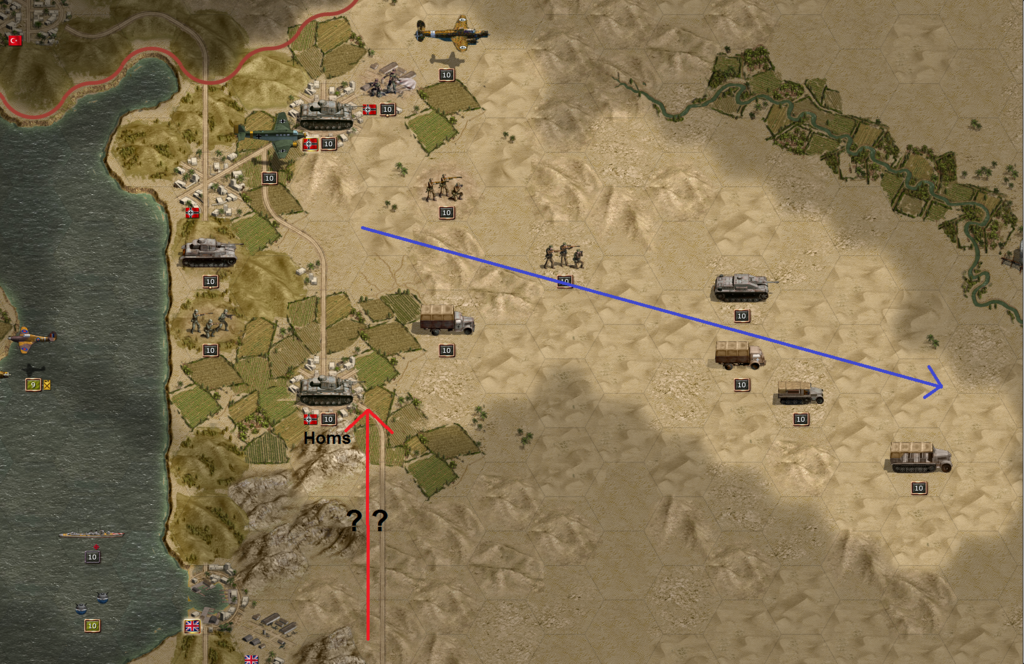
An urgent conference was held by high command and the decision relayed to Rommel, who is responsible for the Middle East forces - Given the lack of suitable defensive positions, the increasingly dire oil situation and the fact that we don’t know which direction the army is heading, Rommel is to continue with the advance on the oilfields and hope that our artillery and other reinforcements will reach the Syrian shore before it is cut off by the advance of the Allied army. To assist in forestalling the Allies, one division of infantry is to be garrisoned in Homs, where it is to block the highway and fight to the death to delay the allied forces. If we are not able to land our artillery before the Allies regain control of the Syrian coast, we will have to rely on our Fallschirmjäger and Pioniere battalions to directly assault any entrenched enemy positions encountered.
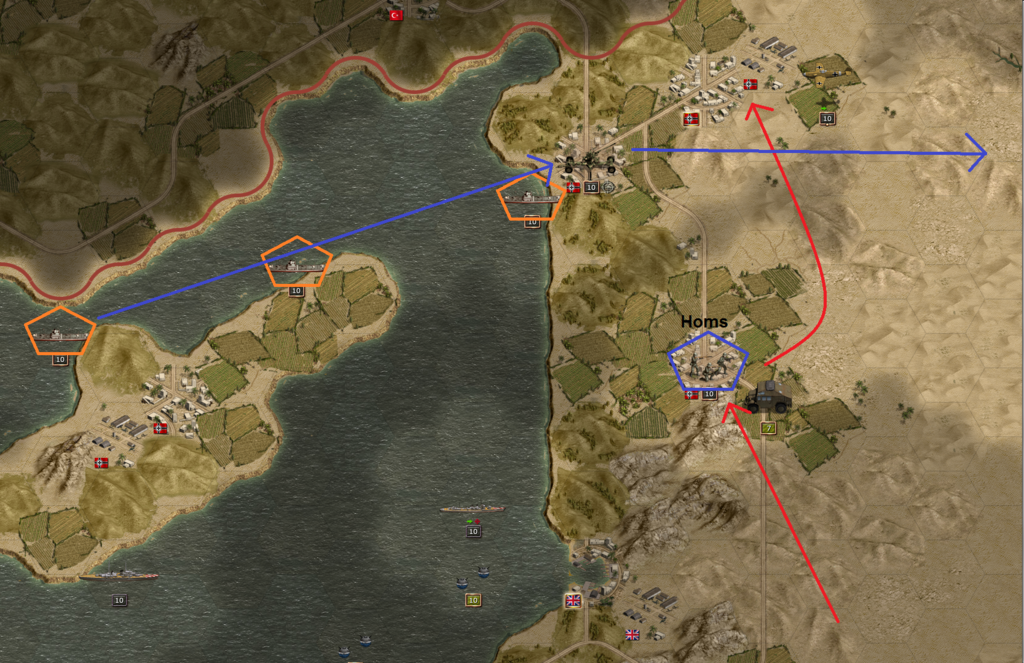
The first of the Allied forces arrives in their push up the Syrian coast. Whilst our infantry garrisoned in Homs slow down the Allied forces, instead of engaging the enemy simply bypasses them to capture Aleppo. Note the transports (orange) heading to the Syrian coast. Two of these transports contain our artillery, whose safe arrival is instrumental to us taking the oilfields.
To make matters even worse, we have been informed of a further Allied mechanized force that has landed off the Persian Gulf and is now headed west towards us. If we don’t beat these forces to the more defensible Euphrates River, we will be trapped between the two Allied forces in what will likely result in the destruction of our entire army.

With a sandstorm clearing it reveals that the Allied reinforcements from the Persian Gulf are in the midst of our forces. A frantic battle ensues to eliminate these forces. Note our Fallshminjaegar which has landed behind the Tigris and will assist in dislodging the entrenched anti tank unit defending the approaches.
In case the Allied army at Suez heads west, we have arranged a strong position in the British prepared defences of Tobruk, which should hopefully be able to hold off the attacking army until the Regia Marina and Luftwaffe are able to assist. For now though there is limited support available as maximum effort is being placed on blocking the American advance on Tunis. Only once this is beaten back will we be able to assist the Tobruk defenders.
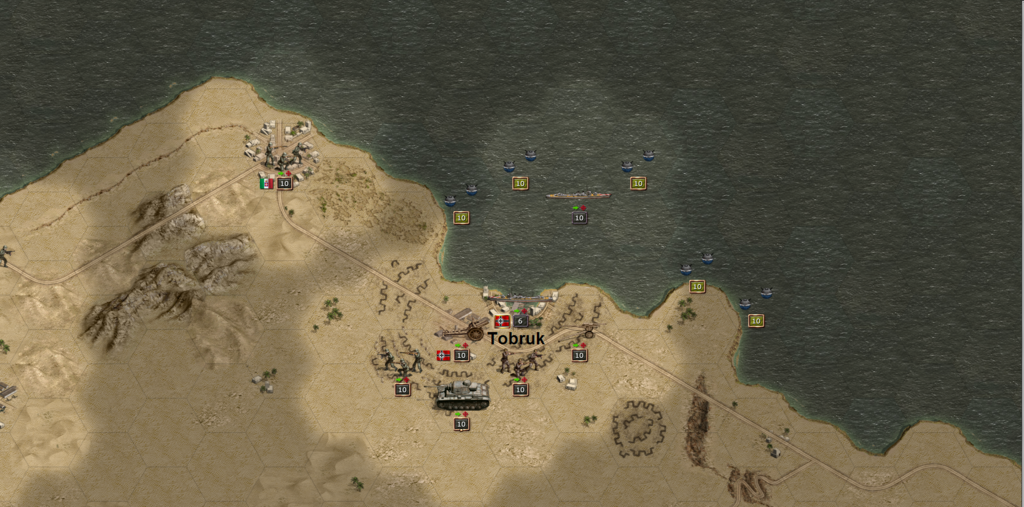
Erwin Rommel’s Pz III battalion was originally earmarked to participate on the drive to the oilfields. However given the lack of transports and much to his chagrin, he is now organising the defence of Tobruk.

However this was suddenly thrown in doubt when intelligence sources informed us of the arrival of a significant armored force around the Suez Canal. We were faced with an agonizing decision – either continue towards the oilfields with our current forces with the hope that our artillery will be able to land before the Allied army re-takes Atakia and Aleppo and cuts off our lines of supply; or else to wait on the Syrian coast with our main forces and directly oppose the Allied army there. We also cannot be sure which direction the Suez army will head – will it be north to recapture the liberated Syrian towns or will they instead head west to Tobruk and further on to Tunis in support of the American Torch landings?

An urgent conference was held by high command and the decision relayed to Rommel, who is responsible for the Middle East forces - Given the lack of suitable defensive positions, the increasingly dire oil situation and the fact that we don’t know which direction the army is heading, Rommel is to continue with the advance on the oilfields and hope that our artillery and other reinforcements will reach the Syrian shore before it is cut off by the advance of the Allied army. To assist in forestalling the Allies, one division of infantry is to be garrisoned in Homs, where it is to block the highway and fight to the death to delay the allied forces. If we are not able to land our artillery before the Allies regain control of the Syrian coast, we will have to rely on our Fallschirmjäger and Pioniere battalions to directly assault any entrenched enemy positions encountered.

The first of the Allied forces arrives in their push up the Syrian coast. Whilst our infantry garrisoned in Homs slow down the Allied forces, instead of engaging the enemy simply bypasses them to capture Aleppo. Note the transports (orange) heading to the Syrian coast. Two of these transports contain our artillery, whose safe arrival is instrumental to us taking the oilfields.
To make matters even worse, we have been informed of a further Allied mechanized force that has landed off the Persian Gulf and is now headed west towards us. If we don’t beat these forces to the more defensible Euphrates River, we will be trapped between the two Allied forces in what will likely result in the destruction of our entire army.

With a sandstorm clearing it reveals that the Allied reinforcements from the Persian Gulf are in the midst of our forces. A frantic battle ensues to eliminate these forces. Note our Fallshminjaegar which has landed behind the Tigris and will assist in dislodging the entrenched anti tank unit defending the approaches.
In case the Allied army at Suez heads west, we have arranged a strong position in the British prepared defences of Tobruk, which should hopefully be able to hold off the attacking army until the Regia Marina and Luftwaffe are able to assist. For now though there is limited support available as maximum effort is being placed on blocking the American advance on Tunis. Only once this is beaten back will we be able to assist the Tobruk defenders.

Erwin Rommel’s Pz III battalion was originally earmarked to participate on the drive to the oilfields. However given the lack of transports and much to his chagrin, he is now organising the defence of Tobruk.
Drive on the Oilfields
The medium armour of the Crusader tanks bypass our defences and Homs and leave it to the Commonwealth infantry, who severely maul our garrisoning forces. Luckily, a dust storm allows our infantry to retreat to the coast, where their presence goes undetected, allowing them to reform. The presence of the Crusader tanks poses a severe threat, as we only have infantry and artillery in the area, which is not enough to counter medium armour. We are saved, however, by the poor tactical decision of the Allied generals. Overly confident of success, they send the tanks into the city of Aleppo to recapture it. This leaves our infantry in the perfect position to attack the tanks in the confined city streets, where we hold the advantage. With our massed artillery we will then easily be able to beat off and destroy the supporting Commonwealth infantry.
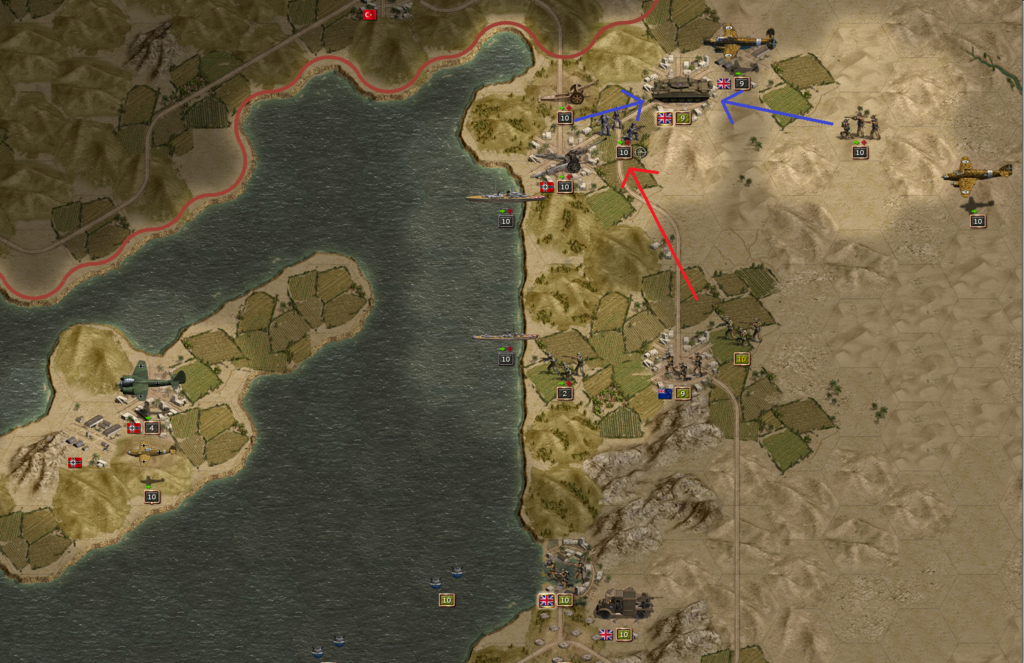
Poor tactical decision making by the Allies will result in the Syrian coast remaining in our hands and will allow our artillery to support the drive on the oilfields
Meanwhile, the battle against the Commonwealth forces around Fallujah goes well. Our medium armour destroys the reinforcements from the Persian Gulf, whilst the Fallschirmjäger and Pioniere capture Fallujah and move towards Baghdad. Baghdad, which is supported by artillery and AA will be harder to take and we plan to attempt river crossings on either side of the city to try and outflank and eliminate the artillery.
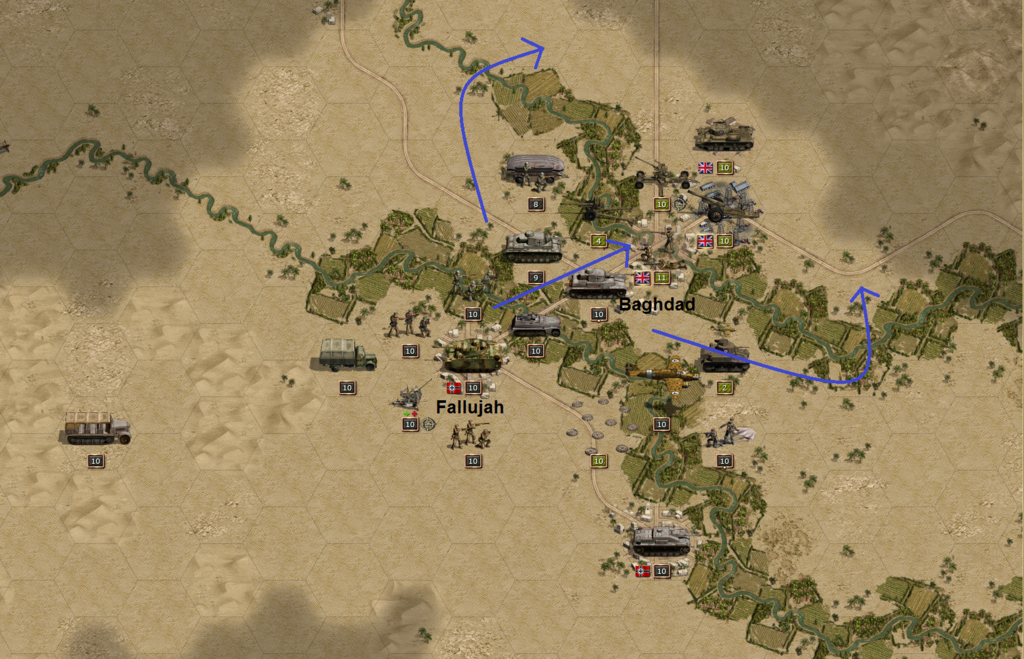
We will attempt a 3 pronged attack on the Commonwealth forces at Baghdad. Directly, from the east and from the west

Poor tactical decision making by the Allies will result in the Syrian coast remaining in our hands and will allow our artillery to support the drive on the oilfields
Meanwhile, the battle against the Commonwealth forces around Fallujah goes well. Our medium armour destroys the reinforcements from the Persian Gulf, whilst the Fallschirmjäger and Pioniere capture Fallujah and move towards Baghdad. Baghdad, which is supported by artillery and AA will be harder to take and we plan to attempt river crossings on either side of the city to try and outflank and eliminate the artillery.

We will attempt a 3 pronged attack on the Commonwealth forces at Baghdad. Directly, from the east and from the west
Battle in the East
The expected Russian counterattack from Kursk finally occurs, with Russian light and medium armour, supported by specialist Siberian infantry first pushing South and later West in an attempt to route our forces. In order to strengthen our defensive line, an order is given to abandon the city of Belgorod and fall back to Kharkov, where we will stand and face the Russian forces.
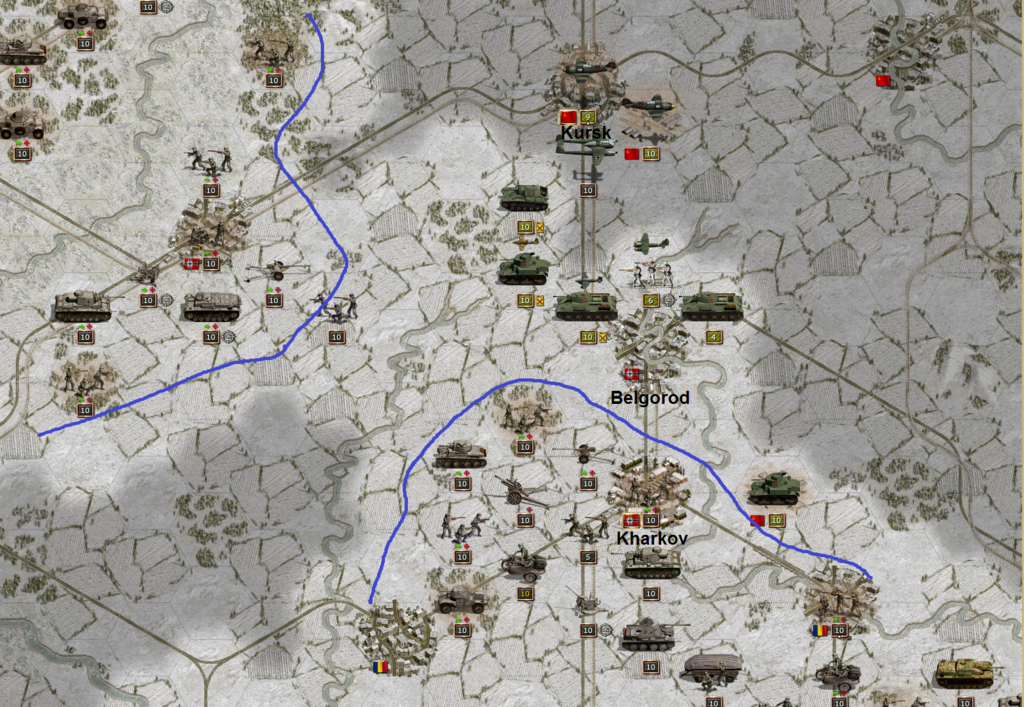
Our forces fall back to a strong defensive line centered on Kharkov and stand ready to face the enemy advance
Given the poor winter weather with many months of snow, we do not have a true idea of the size of the Russian forces opposing us. It is only as the weather clears that we realise the enormity of the Russian army around Kursk and the defensive network facing us. High command recommends to strike and destroy the Russian forces around Kursk before they can consolidate and advance. We are therefore building up our forces further south and once we repel the Russian counter-attacks from Rostov will transfer troops in an effort to destroy the Kursk defenses.

With the winter ending and before we can concentrate our forces for our own attack, the Russians launch a massive counterattack both south and west of Kursk. However we are lucky that the thawing ice has resulted in the rivers once again flowing freely, as this separates the Russian forces so that they can no longer support each other. The Russians first send in their light armour, which is annihilated by our anti tank and medium armour. They then follow this up with infantry and medium armour, which is much harder for us to repel. It is in this fight that the limitations of our Panzer 38(t) is shown, as a full strength, experienced division is almost annihilated by T34’s.
To the west, one of our screening infantry division occupying positions in the forest is annihilated by an overstrength Siberian division <My 10 strength infantry were destroyed in 1 attack by a 12 strength Siberian division – insane!>, whilst another division battles for its life as it is assaulted in the woods by 2 groups of T34, who seem to be willing to absorb significant losses if it means destroying our regiment.
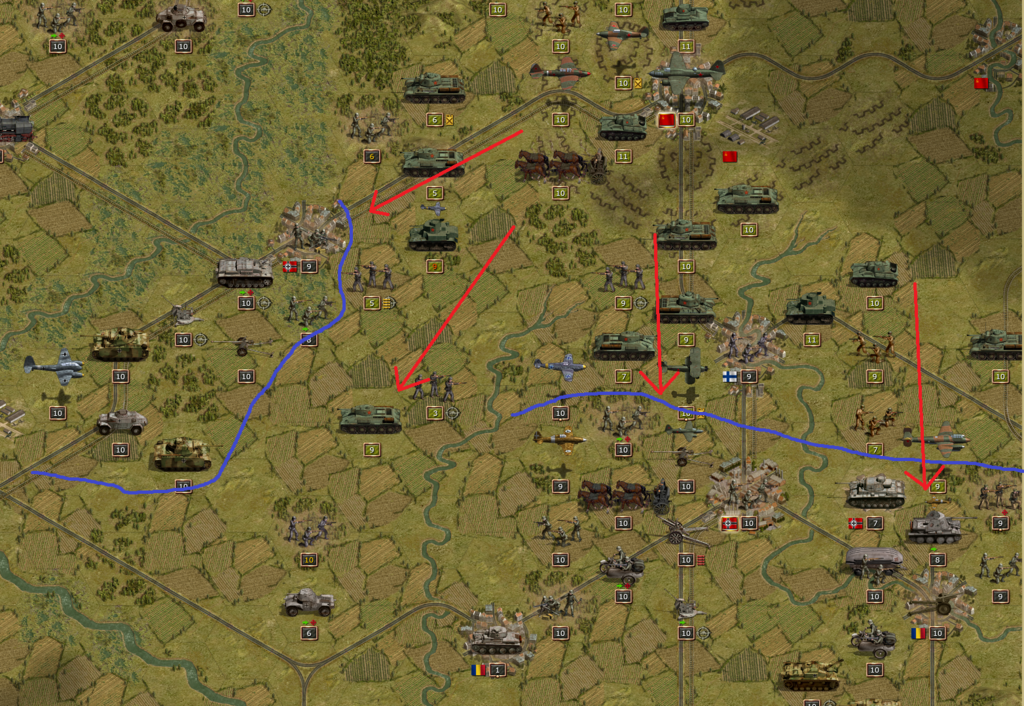
A pitched battle erupts as the Russians advance south and west of Kursk
Closer to the Baltic sea, our forces have withdrawn from Rostov and now form a defensive line on the west bank of the River Mius. A Finnish infantry division and Romanian AT division were destroyed in the retreat, with several other units severely mauled. With the arrival of a Stug and Tiger battalion we were able to stop the Russian’s advance and as the weather cleared the Luftwaffe rained hell on the Russian aggressors. Although the Russian’s rebuilt their air forces during the winter months, we still enjoy air superiority and it is proving incredibly costly to the Russian forces, as we attack and destroy their exposed artillery on its way to the front. We are also able to damage the Russian armour leading the assault allowing our medium tanks to finish off the weakened enemy. We have already left our defensive positions to advance northwards in order to engage and annihilate the enemy located north of Stalino and will soon advance east of the River Mius in an attempt to retake Rostov.
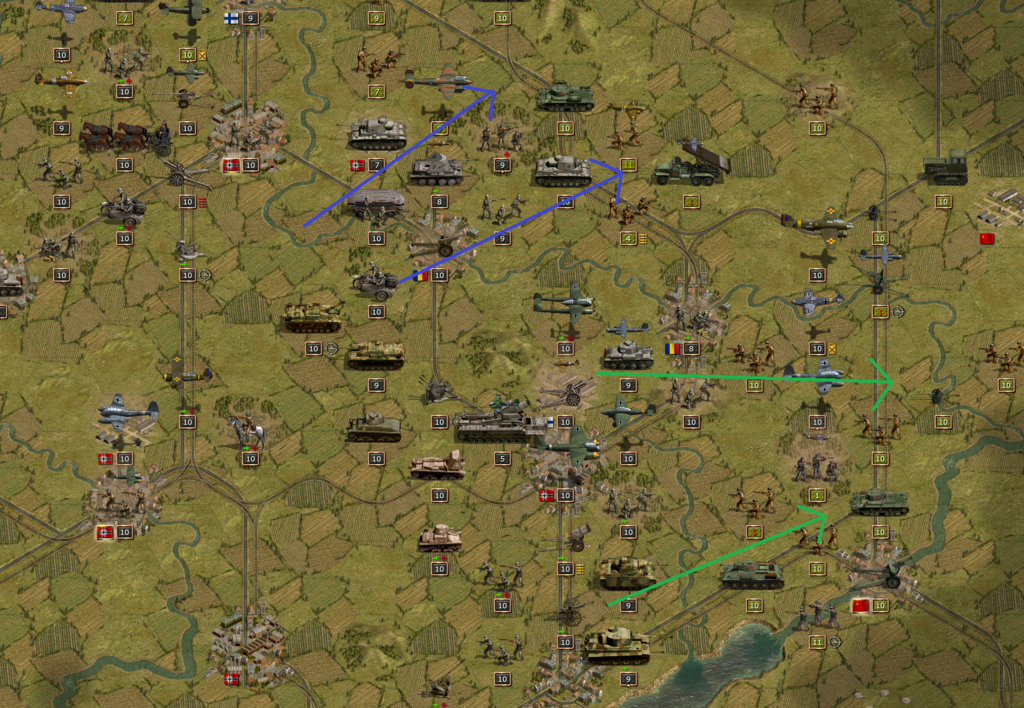
After ceding ground we blunted the initial Russian attack and are now ready to counterattack ourselves. Air superiority is critical in this respect as the Luftwaffe provide close support to our ground forces

Our forces fall back to a strong defensive line centered on Kharkov and stand ready to face the enemy advance
Given the poor winter weather with many months of snow, we do not have a true idea of the size of the Russian forces opposing us. It is only as the weather clears that we realise the enormity of the Russian army around Kursk and the defensive network facing us. High command recommends to strike and destroy the Russian forces around Kursk before they can consolidate and advance. We are therefore building up our forces further south and once we repel the Russian counter-attacks from Rostov will transfer troops in an effort to destroy the Kursk defenses.

With the winter ending and before we can concentrate our forces for our own attack, the Russians launch a massive counterattack both south and west of Kursk. However we are lucky that the thawing ice has resulted in the rivers once again flowing freely, as this separates the Russian forces so that they can no longer support each other. The Russians first send in their light armour, which is annihilated by our anti tank and medium armour. They then follow this up with infantry and medium armour, which is much harder for us to repel. It is in this fight that the limitations of our Panzer 38(t) is shown, as a full strength, experienced division is almost annihilated by T34’s.
To the west, one of our screening infantry division occupying positions in the forest is annihilated by an overstrength Siberian division <My 10 strength infantry were destroyed in 1 attack by a 12 strength Siberian division – insane!>, whilst another division battles for its life as it is assaulted in the woods by 2 groups of T34, who seem to be willing to absorb significant losses if it means destroying our regiment.

A pitched battle erupts as the Russians advance south and west of Kursk
Closer to the Baltic sea, our forces have withdrawn from Rostov and now form a defensive line on the west bank of the River Mius. A Finnish infantry division and Romanian AT division were destroyed in the retreat, with several other units severely mauled. With the arrival of a Stug and Tiger battalion we were able to stop the Russian’s advance and as the weather cleared the Luftwaffe rained hell on the Russian aggressors. Although the Russian’s rebuilt their air forces during the winter months, we still enjoy air superiority and it is proving incredibly costly to the Russian forces, as we attack and destroy their exposed artillery on its way to the front. We are also able to damage the Russian armour leading the assault allowing our medium tanks to finish off the weakened enemy. We have already left our defensive positions to advance northwards in order to engage and annihilate the enemy located north of Stalino and will soon advance east of the River Mius in an attempt to retake Rostov.

After ceding ground we blunted the initial Russian attack and are now ready to counterattack ourselves. Air superiority is critical in this respect as the Luftwaffe provide close support to our ground forces
Other Fronts
Western Europe
Catching us by surprise, the Allies perform a seaborne landing off the coast of Dieppe. With only 2nd rate reserve infantry in the area, we rush a Marder division from central Europe and countered the heavy Allied armour. Although consisting of mostly 2nd rate troops, the 3 divisions of reserve infantry are able to surround and overwhelm the superior Canadian infantry supporting the armour.
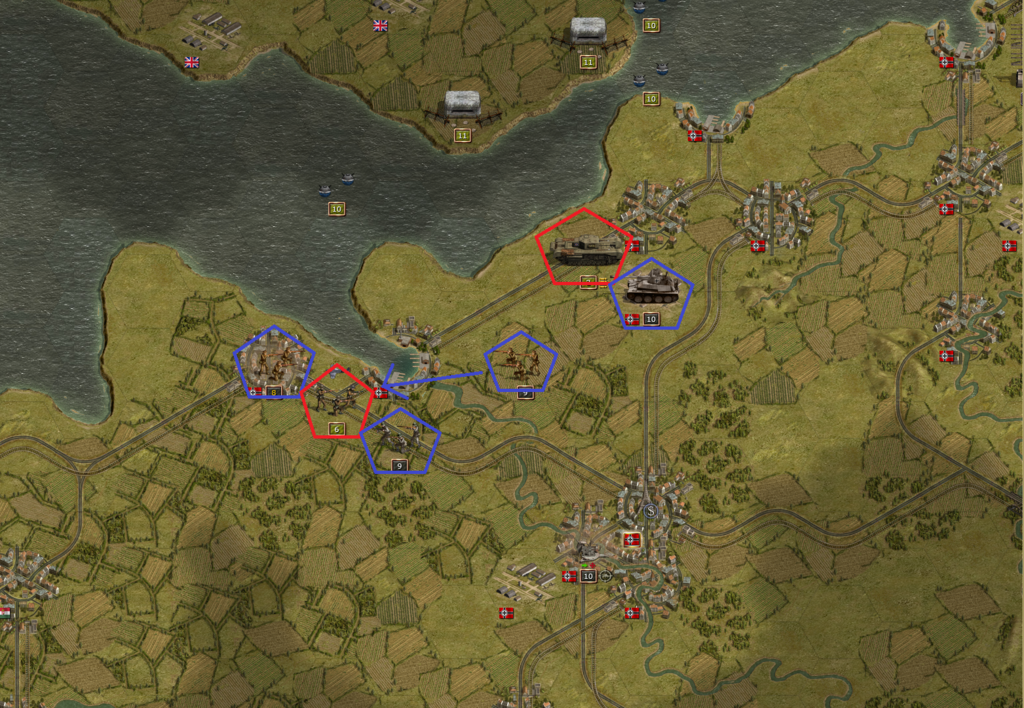
An ill-fated limited invasion attempt by the Allies is swiftly crushed
Black Sea
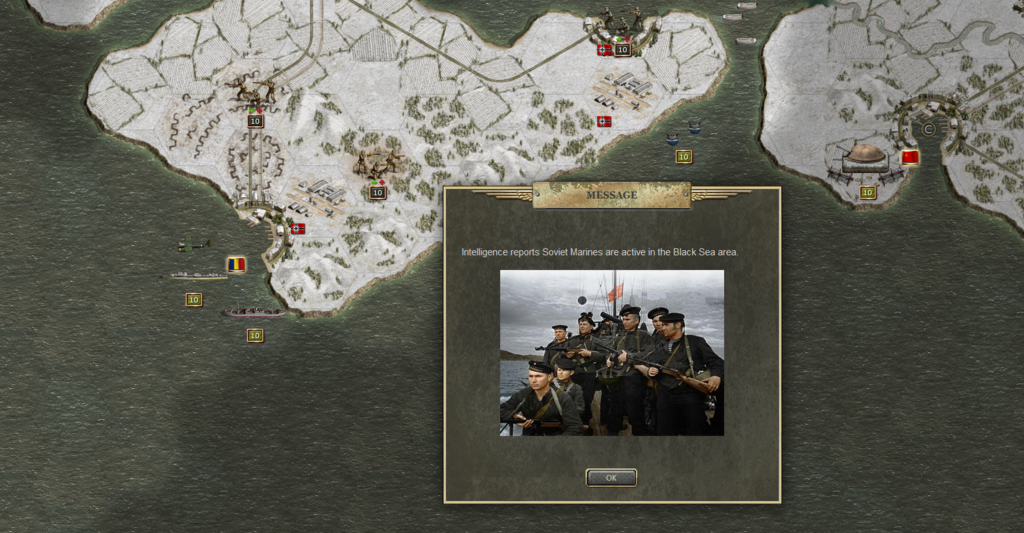
Intelligence reports Russian activity in the the Black Sea. We have therefore garrisoned several units on the Crimean Peninsula to ward off any potential seaborne landing, with further reinforcements within easy reach.
Iceland
The American’s did not take the loss of Iceland lightly and sent a large invasion force to attempt to recapture the country. The poor weather prevented our Condor squadron from intervening, leaving the Kriegsmarine to try and hold out against the American navy. Although they focused on sinking the American transports, they still managed to send 2 destroyers and 1 light cruiser to the bottom of the Atlantic, at the cost of one destroyer and 1 wolfpack. In their task they were mostly successful, with only 1 transport managing to land its cargo. However it was the contents of this cargo that proved catastrophic. Whilst sinking all supporting infantry and artillery, the one transport that landed contained medium armour. With only 2 divisions of German infantry to hold the flat, open terrain of Iceland and with no anti-armour capability we have little hope of being able to drive them off the island, especially as they are supported by a division of paratroopers who flew in to the eastern side of the island. Our vessels have therefore withdrawn east so as to avoid interception by any British vessels patrolling the shipping lanes and will attempt to intervene once the American fleet is first dealt with. However it is considered highly likely that Iceland will now be lost to us.

Many Americans float dead in the icy Atlantic. However of all the units that could survive, the American medium tanks pose the greatest threat to our forces. After performing a fruitless counterattack during which our bullets simply bounced off the tank’s armour, we have issued an order to retreat back to the airfield for aerial evacuation.
Catching us by surprise, the Allies perform a seaborne landing off the coast of Dieppe. With only 2nd rate reserve infantry in the area, we rush a Marder division from central Europe and countered the heavy Allied armour. Although consisting of mostly 2nd rate troops, the 3 divisions of reserve infantry are able to surround and overwhelm the superior Canadian infantry supporting the armour.

An ill-fated limited invasion attempt by the Allies is swiftly crushed
Black Sea

Intelligence reports Russian activity in the the Black Sea. We have therefore garrisoned several units on the Crimean Peninsula to ward off any potential seaborne landing, with further reinforcements within easy reach.
Iceland
The American’s did not take the loss of Iceland lightly and sent a large invasion force to attempt to recapture the country. The poor weather prevented our Condor squadron from intervening, leaving the Kriegsmarine to try and hold out against the American navy. Although they focused on sinking the American transports, they still managed to send 2 destroyers and 1 light cruiser to the bottom of the Atlantic, at the cost of one destroyer and 1 wolfpack. In their task they were mostly successful, with only 1 transport managing to land its cargo. However it was the contents of this cargo that proved catastrophic. Whilst sinking all supporting infantry and artillery, the one transport that landed contained medium armour. With only 2 divisions of German infantry to hold the flat, open terrain of Iceland and with no anti-armour capability we have little hope of being able to drive them off the island, especially as they are supported by a division of paratroopers who flew in to the eastern side of the island. Our vessels have therefore withdrawn east so as to avoid interception by any British vessels patrolling the shipping lanes and will attempt to intervene once the American fleet is first dealt with. However it is considered highly likely that Iceland will now be lost to us.

Many Americans float dead in the icy Atlantic. However of all the units that could survive, the American medium tanks pose the greatest threat to our forces. After performing a fruitless counterattack during which our bullets simply bounced off the tank’s armour, we have issued an order to retreat back to the airfield for aerial evacuation.
1943
The Russian’s opened a new front by advancing with infantry and artillery across the Kerch Strait towards the city of Kerch. With one Heer infantry division in the city and 2 Romanian infantry divisions in Sevastopol we felt confident of stopping this threat. However, just as our Romanian allies moved in the direction of Kerch, Russian landing ships appeared off Sevastopol. We have therefore had to divert the Romanians back to Sevastopol to counter this threat, whilst the Luftwaffe have been called in to assist our infantry in holding Kerch.
In the center of the front, the enemy have a seemingly never-ending number of units attacking us from Kursk, comprising mostly medium and heavy armour. The enemy is attacking on 2 fronts – to the west in the direction of Kiev and to the south in the direction of Belgorod/Khakov. The Russians focus their attacks on the infantry in the forest the the east of Kharkov, forcing us to constantly rotate out our infantry in order to avoid annihalation. Even then, our troops have almost been wiped out several times as the Russian throw tanks headlong into the forest, with little regard for their own casualties. To the west of Kharkov, the open terrain makes for a difficult defensive position and our forces around Konotop performed an orderly withdrawal after 2 screening infantry divisions in the forests and swamps to the northeast were annihilated. Whilst we are supported by several Panzer III divisions, these are barely able to stand up to the latest model T34’s and we are slowly forced back.
A decision must be urgently made - whether we will continue to hold Konotop, or to instead withdraw back to the much stronger defensive line of Kiev, with its natural barrier of the Dnieper River, as well as significant fortifications on the western side. Whilst this would be much easier to defend, it would result in our southern and northern forces losing contact, making it much harder to provide reinforcements between the northern and southern fronts.
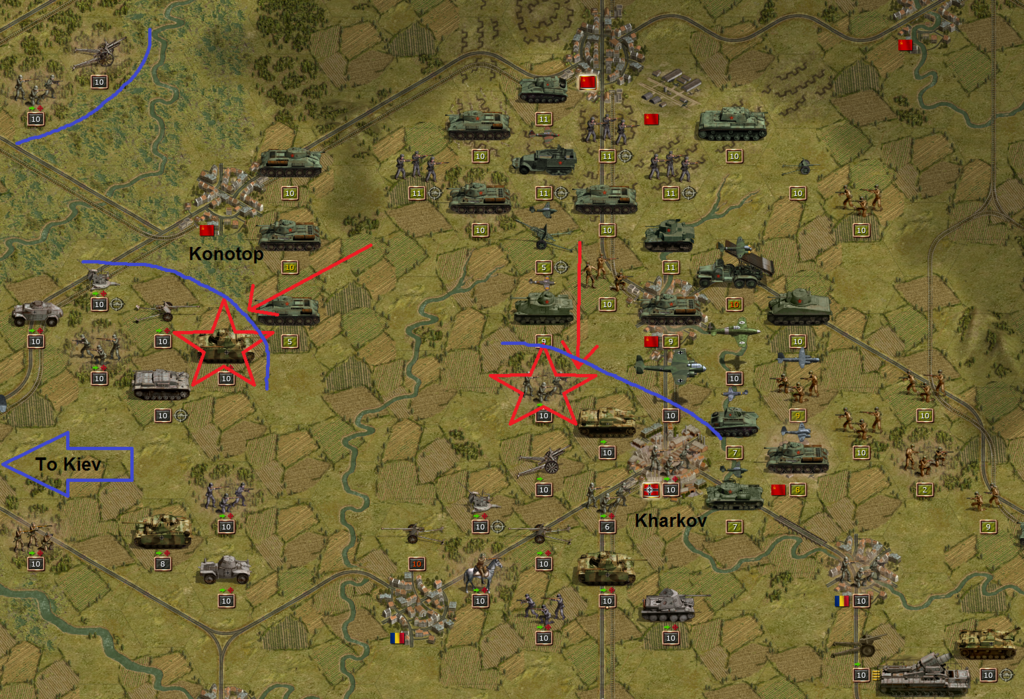
The sheer number of Russian forces almost overwhelms us, however is providing plenty of targets for the Luftwaffe, who control the skies for the moment
The Red air force continually cranks out newer and better planes, but we have maintained constant air superiority along the entire front. This has been done by a combination of constantly upgrading our own forces, immediately reinforcing understrength squadrons and always ensuring our bombers have fighter support. Even with these steps, we have had some close shaves – especially with our Italian fighters, who find it hard to stand up to massed attacks from the latest Russian fighters. However, with the recent development of the Veltro, all Folgore are being recalled and will be replaced by the much stronger Veltro. The excellent Bf 109G-6 has also commenced production, which should further strengthen our air superiority in the east.

The improvements in the latest available aircraft can be readily seen, especially for the Italian developed Veltro.
We experienced our first defeat of the war in the Atlantic, with the Allies once again subjugating Iceland. One infantry division sacrificed itself to allow the other to escape via airlift, after being severely mauled and running short of ammunition. Our capital ships ran out of ammunition and fuel and were therefore unable to support our troops. The remainder of the Kriegsmarine are now withdrawing back to the European mainland, where they will likely be based in the Baltic. As mentioned earlier, the main cause for the loss of Iceland was the American’s landing their medium armour on the island, against which we had nothing to counter. Lesson’s have been learnt and we may yet make another attempt to liberate the country. However for the moment, the few remaining landing craft are needed to transport out troops around the Mediterranean.
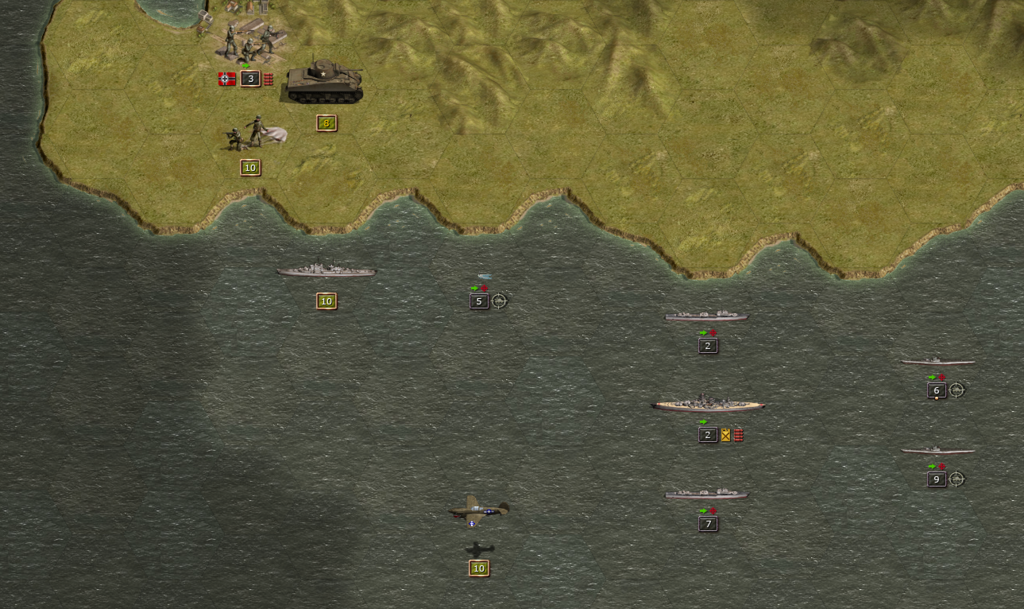
With all ammunition expended, our infantry division, now little more in size than a brigade, managed to board the waiting transports and is now being flown back to Europe. Notice the Battleship Scharnhorst, out of fuel, ammunition and severely damaged. It is now little more than a floating wreck.
In Western Europe, the Allied bombing campaign intensifies. With only 1 squadron of Fw 190’s, we can do relatively little to stop the Allied air forces when they attack in numbers, although our Flak continually whittles away at them. Whilst some consideration has been made regarding stationing another fighter squadron in Western Europe, we have decided against it for 2 main reasons. First, every other front has priority – we would rather have air superiority on other fronts even though it means our cities will be subject to Allied bombing. Secondly, only Fw 190’s can effectively stand up to the Allied fighters operating from Britain and the cost to produce or upgrade one of our existing fighter squadrons to Fw 190’s is one that we are not willing to pay.
In the center of the front, the enemy have a seemingly never-ending number of units attacking us from Kursk, comprising mostly medium and heavy armour. The enemy is attacking on 2 fronts – to the west in the direction of Kiev and to the south in the direction of Belgorod/Khakov. The Russians focus their attacks on the infantry in the forest the the east of Kharkov, forcing us to constantly rotate out our infantry in order to avoid annihalation. Even then, our troops have almost been wiped out several times as the Russian throw tanks headlong into the forest, with little regard for their own casualties. To the west of Kharkov, the open terrain makes for a difficult defensive position and our forces around Konotop performed an orderly withdrawal after 2 screening infantry divisions in the forests and swamps to the northeast were annihilated. Whilst we are supported by several Panzer III divisions, these are barely able to stand up to the latest model T34’s and we are slowly forced back.
A decision must be urgently made - whether we will continue to hold Konotop, or to instead withdraw back to the much stronger defensive line of Kiev, with its natural barrier of the Dnieper River, as well as significant fortifications on the western side. Whilst this would be much easier to defend, it would result in our southern and northern forces losing contact, making it much harder to provide reinforcements between the northern and southern fronts.

The sheer number of Russian forces almost overwhelms us, however is providing plenty of targets for the Luftwaffe, who control the skies for the moment
The Red air force continually cranks out newer and better planes, but we have maintained constant air superiority along the entire front. This has been done by a combination of constantly upgrading our own forces, immediately reinforcing understrength squadrons and always ensuring our bombers have fighter support. Even with these steps, we have had some close shaves – especially with our Italian fighters, who find it hard to stand up to massed attacks from the latest Russian fighters. However, with the recent development of the Veltro, all Folgore are being recalled and will be replaced by the much stronger Veltro. The excellent Bf 109G-6 has also commenced production, which should further strengthen our air superiority in the east.

The improvements in the latest available aircraft can be readily seen, especially for the Italian developed Veltro.
We experienced our first defeat of the war in the Atlantic, with the Allies once again subjugating Iceland. One infantry division sacrificed itself to allow the other to escape via airlift, after being severely mauled and running short of ammunition. Our capital ships ran out of ammunition and fuel and were therefore unable to support our troops. The remainder of the Kriegsmarine are now withdrawing back to the European mainland, where they will likely be based in the Baltic. As mentioned earlier, the main cause for the loss of Iceland was the American’s landing their medium armour on the island, against which we had nothing to counter. Lesson’s have been learnt and we may yet make another attempt to liberate the country. However for the moment, the few remaining landing craft are needed to transport out troops around the Mediterranean.

With all ammunition expended, our infantry division, now little more in size than a brigade, managed to board the waiting transports and is now being flown back to Europe. Notice the Battleship Scharnhorst, out of fuel, ammunition and severely damaged. It is now little more than a floating wreck.
In Western Europe, the Allied bombing campaign intensifies. With only 1 squadron of Fw 190’s, we can do relatively little to stop the Allied air forces when they attack in numbers, although our Flak continually whittles away at them. Whilst some consideration has been made regarding stationing another fighter squadron in Western Europe, we have decided against it for 2 main reasons. First, every other front has priority – we would rather have air superiority on other fronts even though it means our cities will be subject to Allied bombing. Secondly, only Fw 190’s can effectively stand up to the Allied fighters operating from Britain and the cost to produce or upgrade one of our existing fighter squadrons to Fw 190’s is one that we are not willing to pay.
Africa & the Middle East
Torch
Our forces rushing to the area arranged defences in 2 main positions. To the south west of Tunis at the eastern exit of the Kasserine pass we saw strong attacks by Allied infantry and medium armour. This was stopped and destroyed by our forces consisting of infantry, artillery and AA. By rotating infantry to the narrow exit of the pass and supported by artillery, we were able to block the attackers and destroy them, one after another. When faced with medium armour, our 8.8cm Flak would switch to AT mode and annihilate it, whilst providing protection against allied air attacks at other times. The enemy are now regrouping and we expect them to make another push on the pass.
Whilst soon attacking through Kasserine Pass, the Allies were slower to advance along the coastal road, giving our forces sufficient time to occupy their defensive positions to the west of Tunis. Our main defences consisted of AT and medium armour, backed up by artillery and AA. Further south, infantry hold the line so as to prevent any outflanking attempts, although they are poorly situated on flat terrain and will suffer significant casualties if attacked by armour.
The Allies performed an outflanking maneouver with SPAT and SPAA units far to the south, catching us unprepared. However, rather than swinging north towards Tunis, they are heading towards Gabes and further east, looking to capture our ports, airfields and towns on the coast. As they are unsupported our infantry and light armour, supported by naval gunfire should be able to defeat them once we can catch up to them.

The Allies outflank our defensive line at Kasserine Pass, although as they are unsupported, they pose more a nuisance than a threat
Allied naval forces arrive to the area in a piecemeal fashion, allowing our Ju 88’s to target each in turn. Already a aircraft carrier, light cruiser and destroyer squadron lie at the bottom of the Med and 2 more destroyers are being bombarded. Allied submarines are operating in the area, which forces the Regia Marina to keep their distance. The Allies then bring in their big guns, with 3 battleships arriving. And so begins the largest battle naval battle of WW2. With no fighter cover protecting the enemy vessels, our Ju 88’s and Hs 129B perform bombing runs on the Battleships and submarine, respectively. Our own uboats then move in and lunch torpedo attacks on the Battleships, crippling them. Finally, the Regia Marina moves in from the north and south to mercilessly bombard the Battleships until they are little more than smoldering ruins. Our own destroyers then go to work on the enemy submarines, dropping depth charges and attempting to ram them as they surface, utterly destroying them.
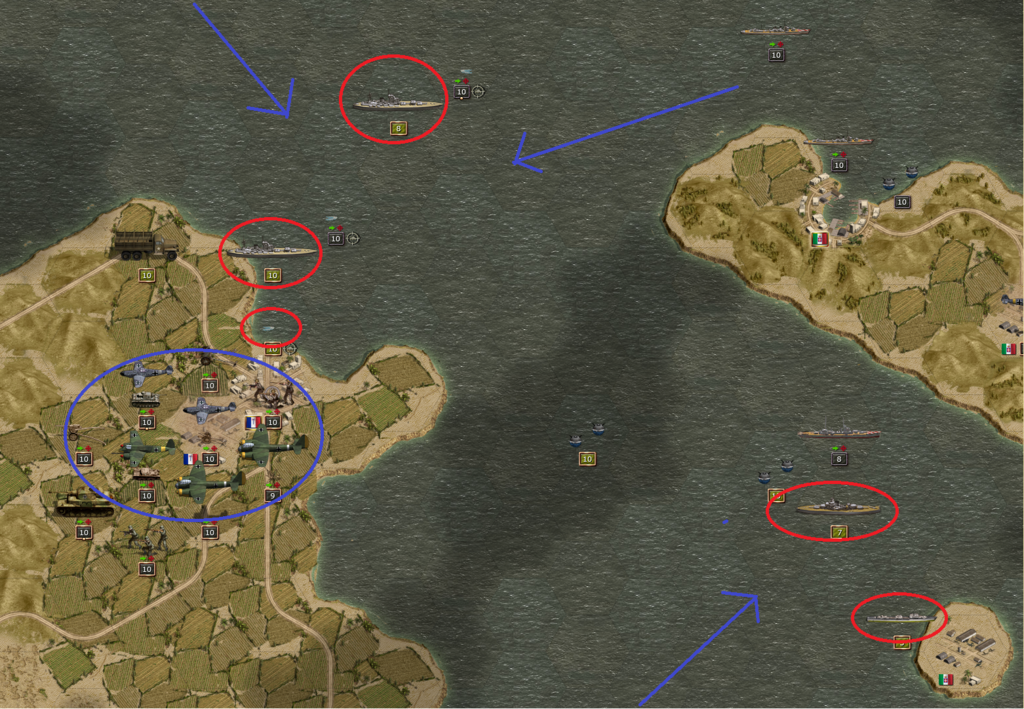
In a perfectly coordinated attack by the Luftwaffe and Regia Marina, the entirety of the formidable Allied Naval force is destroyed
Drive on the oilfields
The Allies attack up the Syrian coast in order to try and cut off our forces from resupply. Thankfully, these attacks are sporadic and mostly unsupported, but they are tying up our forces which would otherwise be assisting our attack on Baghdad. We have captured Fallujah and destroyed all enemy lying between the Euphrates and Tigris Rivers. The attack on Baghdad itself is proving troublesome as it is strongly garrisoned and supported by both artillery and AA. Therefore we performed a flanking action by crossing the Tigris to both the northwest and southeast of Baghdad. Under the cover of a sandstorm, we were able to do this undetected and are now poised to destroy the Allied defense of Baghad and capture the oilfields for the Reich. A Commonwealth battlegroup to the north of Baghdad poses a serious threat and will have to be engaged to prevent them from assisting the defenders of Baghdad.
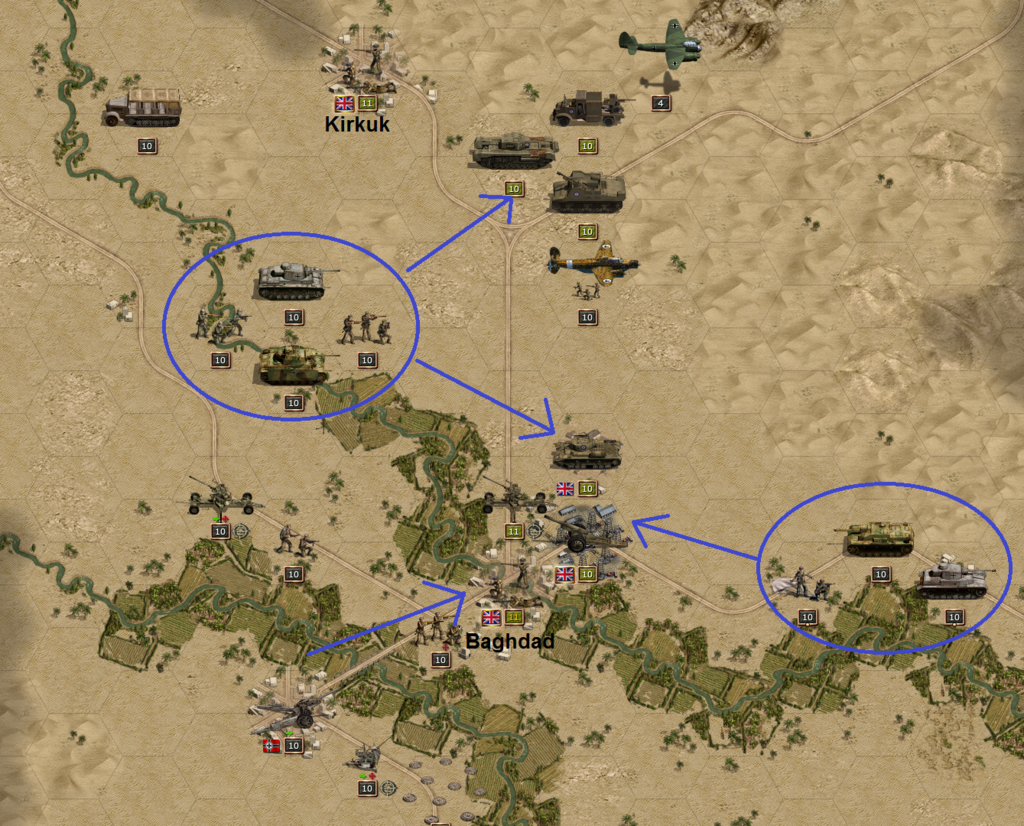
We successfully cross the Tigris and will soon envelop and destroy the Baghdad defences. The Churchill tank to the north poses a significant threat as we have nothing with which to counter its heavy armour.
Tobruk
Constant attacks by the Allies up the Syrian coast led us to believe that this was the large force which had arrived via the Suez canal. Although the attacks on the Syrian coast were persistent, they were made with mostly light forces. This should have been warning enough as our spies had informed us of significant heavy armour, however we were still caught by surprise when medium and heavy tanks rolled up to the approaches of Tobruk and began engaging our entrenched AT and infantry. Rommel, who had only just departed alongside his Panzer III division for the Syrian coast was quickly recalled and a frantic defense ensued. Although heavily entrenched, our forces mostly consist of second rate Italian infantry, artillery and AT units. These units will be able to hold their positions for a time, but are unlikely to cause much damage to the enemy and will need to withdraw at some point in order to replace losses. We have therefore re-routed a Stug battalion which was on the way to Tunisia and combined with Rommel’s panzer III’s these should add some backbone and punch to our defences. Only a light cruiser fromt the Regia Marina is available to lend its support, as the rest of our naval power is assisting in repelling Operation Torch. In air power, we have called on Rudel and his Stuka squadron, supported by a Bf 109 squadron, to help crack the Allied heavy armour. Hopefully these units will be enough to sure up the defences and defeat the Allied attack.

Rommel frantically coordinates the defence of Tobruk, urgently requesting reinforcement so as to be able to counter the British tanks
The Allied tanks perform frontal assaults against our Italian AT and infantry divisions in the eastern defences of Tobruk, slowly inflicting casualties whilst suffering a not insignificant number of casualties themselves. However, with the arrival of the Stug division and Rudel’s Ju 87G squadron, the tables have turned. One after another the Allied tanks are knocked out – first, the Junkers scream in to attack, damaging, destroying and scattering the enemy. This is then followed up by a combined attack by the Stug’s and Panzer III’s, which annihilate those units which survived the bombing. All this while the Italian artillery and light cruiser lob shells onto the enemy. In short order, the entire Allied force is defeated and Libya is saved.
Our forces rushing to the area arranged defences in 2 main positions. To the south west of Tunis at the eastern exit of the Kasserine pass we saw strong attacks by Allied infantry and medium armour. This was stopped and destroyed by our forces consisting of infantry, artillery and AA. By rotating infantry to the narrow exit of the pass and supported by artillery, we were able to block the attackers and destroy them, one after another. When faced with medium armour, our 8.8cm Flak would switch to AT mode and annihilate it, whilst providing protection against allied air attacks at other times. The enemy are now regrouping and we expect them to make another push on the pass.
Whilst soon attacking through Kasserine Pass, the Allies were slower to advance along the coastal road, giving our forces sufficient time to occupy their defensive positions to the west of Tunis. Our main defences consisted of AT and medium armour, backed up by artillery and AA. Further south, infantry hold the line so as to prevent any outflanking attempts, although they are poorly situated on flat terrain and will suffer significant casualties if attacked by armour.
The Allies performed an outflanking maneouver with SPAT and SPAA units far to the south, catching us unprepared. However, rather than swinging north towards Tunis, they are heading towards Gabes and further east, looking to capture our ports, airfields and towns on the coast. As they are unsupported our infantry and light armour, supported by naval gunfire should be able to defeat them once we can catch up to them.

The Allies outflank our defensive line at Kasserine Pass, although as they are unsupported, they pose more a nuisance than a threat
Allied naval forces arrive to the area in a piecemeal fashion, allowing our Ju 88’s to target each in turn. Already a aircraft carrier, light cruiser and destroyer squadron lie at the bottom of the Med and 2 more destroyers are being bombarded. Allied submarines are operating in the area, which forces the Regia Marina to keep their distance. The Allies then bring in their big guns, with 3 battleships arriving. And so begins the largest battle naval battle of WW2. With no fighter cover protecting the enemy vessels, our Ju 88’s and Hs 129B perform bombing runs on the Battleships and submarine, respectively. Our own uboats then move in and lunch torpedo attacks on the Battleships, crippling them. Finally, the Regia Marina moves in from the north and south to mercilessly bombard the Battleships until they are little more than smoldering ruins. Our own destroyers then go to work on the enemy submarines, dropping depth charges and attempting to ram them as they surface, utterly destroying them.

In a perfectly coordinated attack by the Luftwaffe and Regia Marina, the entirety of the formidable Allied Naval force is destroyed
Drive on the oilfields
The Allies attack up the Syrian coast in order to try and cut off our forces from resupply. Thankfully, these attacks are sporadic and mostly unsupported, but they are tying up our forces which would otherwise be assisting our attack on Baghdad. We have captured Fallujah and destroyed all enemy lying between the Euphrates and Tigris Rivers. The attack on Baghdad itself is proving troublesome as it is strongly garrisoned and supported by both artillery and AA. Therefore we performed a flanking action by crossing the Tigris to both the northwest and southeast of Baghdad. Under the cover of a sandstorm, we were able to do this undetected and are now poised to destroy the Allied defense of Baghad and capture the oilfields for the Reich. A Commonwealth battlegroup to the north of Baghdad poses a serious threat and will have to be engaged to prevent them from assisting the defenders of Baghdad.

We successfully cross the Tigris and will soon envelop and destroy the Baghdad defences. The Churchill tank to the north poses a significant threat as we have nothing with which to counter its heavy armour.
Tobruk
Constant attacks by the Allies up the Syrian coast led us to believe that this was the large force which had arrived via the Suez canal. Although the attacks on the Syrian coast were persistent, they were made with mostly light forces. This should have been warning enough as our spies had informed us of significant heavy armour, however we were still caught by surprise when medium and heavy tanks rolled up to the approaches of Tobruk and began engaging our entrenched AT and infantry. Rommel, who had only just departed alongside his Panzer III division for the Syrian coast was quickly recalled and a frantic defense ensued. Although heavily entrenched, our forces mostly consist of second rate Italian infantry, artillery and AT units. These units will be able to hold their positions for a time, but are unlikely to cause much damage to the enemy and will need to withdraw at some point in order to replace losses. We have therefore re-routed a Stug battalion which was on the way to Tunisia and combined with Rommel’s panzer III’s these should add some backbone and punch to our defences. Only a light cruiser fromt the Regia Marina is available to lend its support, as the rest of our naval power is assisting in repelling Operation Torch. In air power, we have called on Rudel and his Stuka squadron, supported by a Bf 109 squadron, to help crack the Allied heavy armour. Hopefully these units will be enough to sure up the defences and defeat the Allied attack.

Rommel frantically coordinates the defence of Tobruk, urgently requesting reinforcement so as to be able to counter the British tanks
The Allied tanks perform frontal assaults against our Italian AT and infantry divisions in the eastern defences of Tobruk, slowly inflicting casualties whilst suffering a not insignificant number of casualties themselves. However, with the arrival of the Stug division and Rudel’s Ju 87G squadron, the tables have turned. One after another the Allied tanks are knocked out – first, the Junkers scream in to attack, damaging, destroying and scattering the enemy. This is then followed up by a combined attack by the Stug’s and Panzer III’s, which annihilate those units which survived the bombing. All this while the Italian artillery and light cruiser lob shells onto the enemy. In short order, the entire Allied force is defeated and Libya is saved.
Summer/Autumn '43
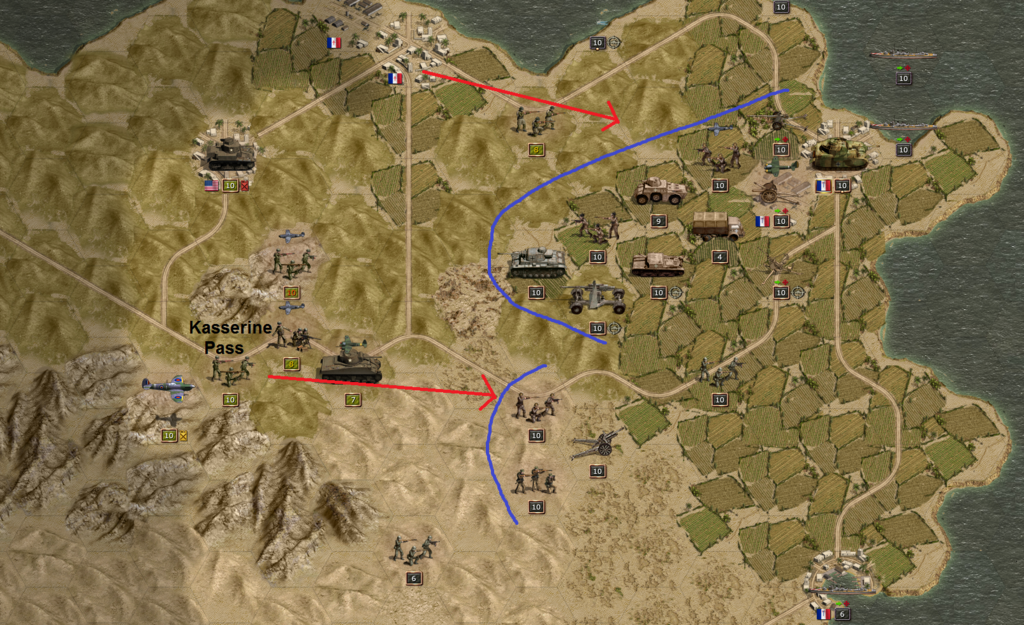
After holding the Kasserine Pass for several months, the arrival of the Allied artillery proves decisive, with our forces being blasted out of their defensive positions. The American’s have also started attacking along the coastal road, where our troops are maintaining position on the plains. We perform an orderly withdrawal from the Kasserine Pass, although one screening infantry division is annihilated in the process. It is hoped that with the support of the Luftwaffe and Regia Marina, we will be able to drive them back and liberate North Africa.
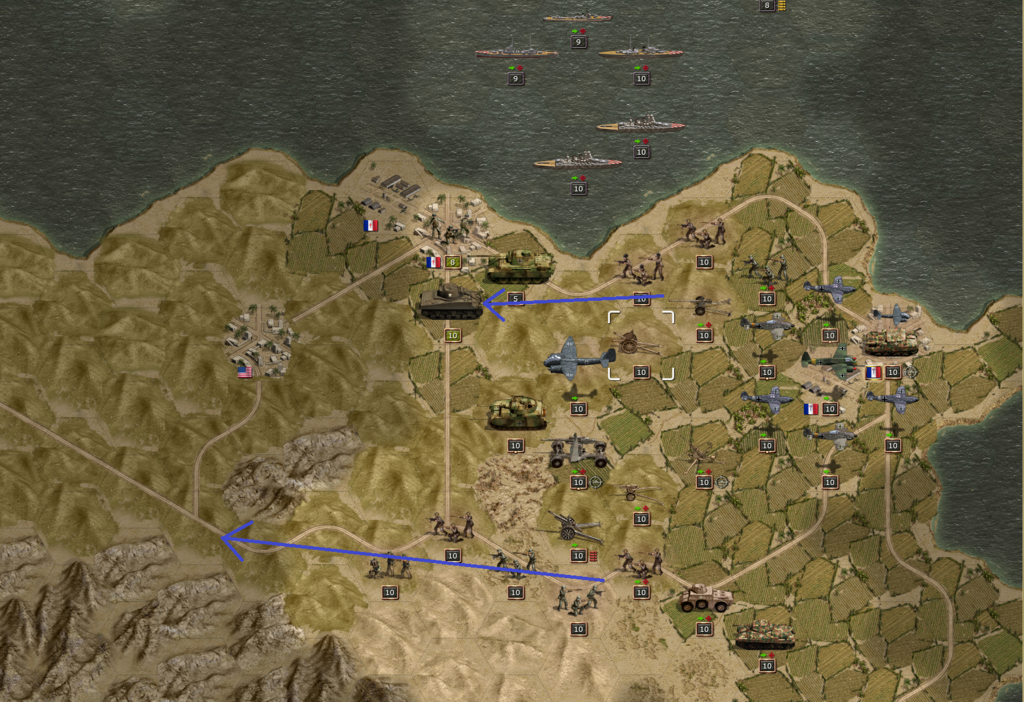
With the Allied Naval forces destroyed and air supremacy obtained, we regained the initiative. Our infantry in the hills, supported by artillery bore the brunt of the Allied assault. However we then outflanked and counterattacked the Allies, destroying them one after the other. With Autumn drawing to an end and mindful of the need to relocate our forces to Western Europe, an order was given to leave our defensive positions and go on the offensive. Around half our forces are now surging forward in an effort to liberate North Africa. The remainder of our forces are heading to available ports in order to transfer to Western Europe.
After considering falling back to the defences around Kiev, we regained momentum with the help of the Luftwaffe and have now recaptured the city of Konotop. Whilst the Luftwaffe proved essential in blunting the Russian attack, it was the upgrading of our Panzer III’s to Panther A’s that proved decisive. Our old Panzer III’s were inferior compared to the latest model T34 and were suffering heavy casualties in holding back the Russians. The new Panther A tank far surpasses anything that the Russian’s can field and has once resulted in us regaining the initiative.

Whilst the Panzer III is inferior to the T34, the Panther A is far superior
Around the same time, a decision was made to upgrade our ground attack aircraft (primarily our Junker 87’s) to Fw 190F. Whilst the damage of the Ju87’s (both physically and psychologically) was superior, their vulnerability to enemy fighters, even when escorted, proved too costly. Modifications were also made to our Junker 88 strategic bombers to improve their frames and fit them with better air defenses so as to better repel enemy fighters, resulting in all 88’s being upgraded to the new 188 variant.

Our planes are undergoing modification to make them more resilient against Allied fighters
These upgrades have come at significant cost and have resulted in us expending approximately two thirds of our resources. The Allied bombers are also proving highly effective at disrupting our industrial output, further stunting our ability to equip our forces. It is hoped that we can capture significant supplies and equipment during the liberation of North Africa, now that we seem to have mostly defeated the attackers of Operation Torch. We should also see a significant increase in oil reserves with two oilfields under our control and another soon to be captured.
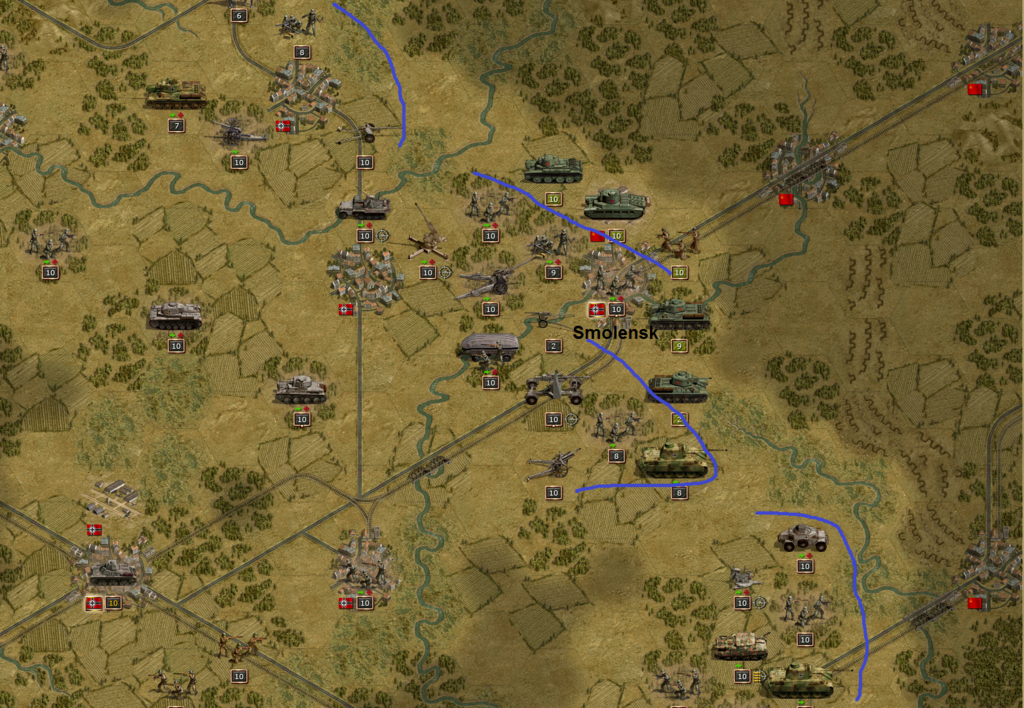
The standoff around Smolensk continues, with the Russians occasionally attempting an advance, only to be brutally beaten back on each occasion
Analysis
With Autumn drawing to an end and Winter approaching, our forces are in a strong position. We have checked all Russian advances on the eastern front and have pushed past our original defensive positions in order to hunt the Russian armour centered around Kursk. Whilst we do not intend to capture Kursk before the onset of winter, we aim to significantly reduce the Russian forces in the area so as to stunt their ability to counterattack us during winter. In the winter of ’42 we were hit hard by the Russians around Rostov as they took advantage of the frozen rivers. For the upcoming winter we have determined to commence a withdrawal to more defendable positions as soon as the first snow falls. This will see us pull back behind the Mius River. We will also re-align our defences around Kharkov by reinforcing it with armour and AT so as to protect our exposed flanks once the rivers freeze.

With rain falling and snow forecast for the following weeks we take advantage of the reduced visibility to perform a staged withdrawal to the western side of the Mius River (green).
In mid winter we will commence shifting some of our forces to the western front, so as to allow them sufficient time to entrench in anticipation of the expected Allied landings in the summer of ‘44. In this respect, it is essential that we quickly and decisively defeat the Allies in the Middle East and Africa, so that these forces can be transferred to Western Europe. The reduction of the Allies in Egypt is expected to take significant time, given their heavily entrenched positions. Therefore significant effort will be made to defeat the Torch landings, with our forces switching from a defensive, to offensive posture, now that we have blunted the main assault on Tunis. In this respect, we are willing to accept additional casualties if it allows us to defeat the Americans in sufficient time to transfer our troops. Gaining control of North Africa has the additional benefit of securing our southern flank, allowing us to concentrate our troops in the East and West.
The bombing campaign by the Allies is proving particularly effective. Whilst we damage the Allied planes with our massed AA, they successfully bomb on average 2 major cities each week. One squadron of Fw’s is simply insufficient to counter them. However given the tight resource situation, we have no intention of upgrading any of our Bf 109’s to Fw’s. We are also extremely hesitant to bring any Bf 109’s to the Western European theatre given the Allies ability to shoot them down. Rather, we prefer to maintain air superiority in the East.

With rain falling and snow forecast for the following weeks we take advantage of the reduced visibility to perform a staged withdrawal to the western side of the Mius River (green).
In mid winter we will commence shifting some of our forces to the western front, so as to allow them sufficient time to entrench in anticipation of the expected Allied landings in the summer of ‘44. In this respect, it is essential that we quickly and decisively defeat the Allies in the Middle East and Africa, so that these forces can be transferred to Western Europe. The reduction of the Allies in Egypt is expected to take significant time, given their heavily entrenched positions. Therefore significant effort will be made to defeat the Torch landings, with our forces switching from a defensive, to offensive posture, now that we have blunted the main assault on Tunis. In this respect, we are willing to accept additional casualties if it allows us to defeat the Americans in sufficient time to transfer our troops. Gaining control of North Africa has the additional benefit of securing our southern flank, allowing us to concentrate our troops in the East and West.
The bombing campaign by the Allies is proving particularly effective. Whilst we damage the Allied planes with our massed AA, they successfully bomb on average 2 major cities each week. One squadron of Fw’s is simply insufficient to counter them. However given the tight resource situation, we have no intention of upgrading any of our Bf 109’s to Fw’s. We are also extremely hesitant to bring any Bf 109’s to the Western European theatre given the Allies ability to shoot them down. Rather, we prefer to maintain air superiority in the East.
Last edited by JimmyC on Sat Apr 15, 2017 12:46 am, edited 1 time in total.
Winter '44
With snow falling and the rivers frozen the Russian’s commence their winter offensive. In the prior year this fell on army group south around the area of Rostov and Kharkov. In anticipation of this we abandoned Rostov and pulled our forces back to the western side of the Mius in an orderly withdrawal. We also sent armoured reinforcements in the form of Panthers and Stugs to the area around Kharkov. However, perhaps as a result of our efforts to reduce the Russian armour around Kursk, the Russians chose note to attack on this front. Instead, they performed a massed assault against army group north, with overstrength T34’s, backed by elite infantry and heavy IS tanks. Although we occupied strong defensive positions at Smolensk, the Russians attacked in the relatively flat terrain to the south. Although causing significant casualties to the Russians, with only 2 Panther divisions in the area, we were unable to repel the attacks, forcing us to withdraw our defences from the south of the city. This in turn left Smolensk unsupported by artillery and the Russians commenced directly assaulting the city.
Whilst we have significant ground attack aircraft in the area ready to interdict the Russian armour, the poor weather results in all planes being grounded. Once the weather clears, the Russians will face the full force of the Luftwaffe. In the interim, 2 Panther divisions are being transferred from army group south in an effort to assist in stabilizing the situation.
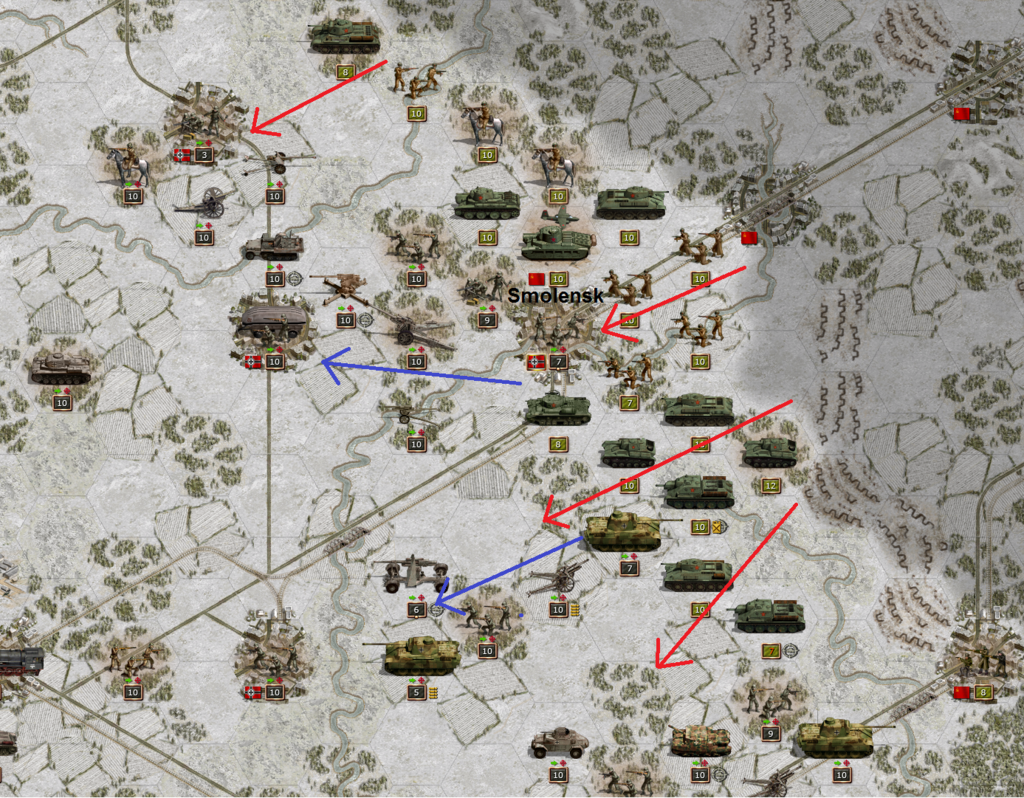
The Russian winter attack falls on Army Group North. An orderly retreat is performed south of Smolensk whilst reinforcements rush to the area. The city of Smolensk may also need to be abandoned, although it is difficult to extract our garrison safely.
Our desert forces faced considerable opposition in our assault on the city and adjacent oilfield of Basra. The British, supported by a battleship and aircraft carrier, strongly resisted the initial assault from the north east by our Pioniere division, backed by artillery. It was only when we had brought up armour and infantry in the south east and attacked the city on 2 sides, that we were successful in reducing the British defences. With the 2nd oilfield of the Middle East finally captured, we finally have a sufficient supply of oil to operate all capital ships of the Regia Marina whilst also providing an additional source of income.

The strong defences around Basra and the port of Umm Qasr prove stronger than expected, but can do no more than delay the capture of the oilfield
The time taken to capture the oilfields was significantly longer than originally envisaged, due both to the strength of the defenders and poor staff planning. With an Allied amphibious assault in France expected to occur in the summer of ’44 (only 6 months away), we have therefore determined to no longer attempt an assault on the Russian oilfields. Instead, our desert force will focus on mopping up remaining British resistance before performing a final assault on Egypt. This will leave the entire Middle East and North Africa in our hands and will allow us to transfer the majority of our forces to Europe to assist in the defence of liberated territories.
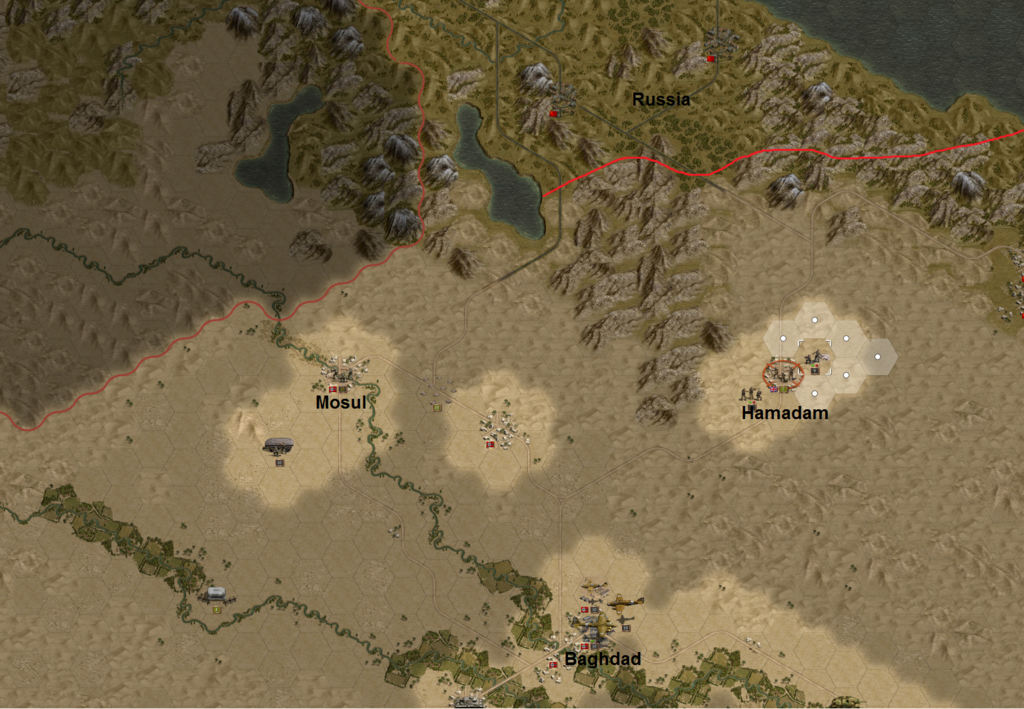
Our forces push north but intend to stop once we reach the Russian border. A skeleton force will be left to man the border, as we don’t expect any significant Russian attacks on this front.
After seeing off sporadic attacks up the Syrian coast, which contributed to our delay in capturing the oilfields, our forces in the area have now adopted an offensive posture and commenced advancing down the Syrian coast. Only Beirut and Jerusalem remain occupied, but will soon be liberated by our forces. Once Jerusalem is captured, we will probe the Egyptian defenses, but will wait until reinforcements arrive from Basra before performing the main assault to drive Commonwealth forces out of North Africa once and for all.
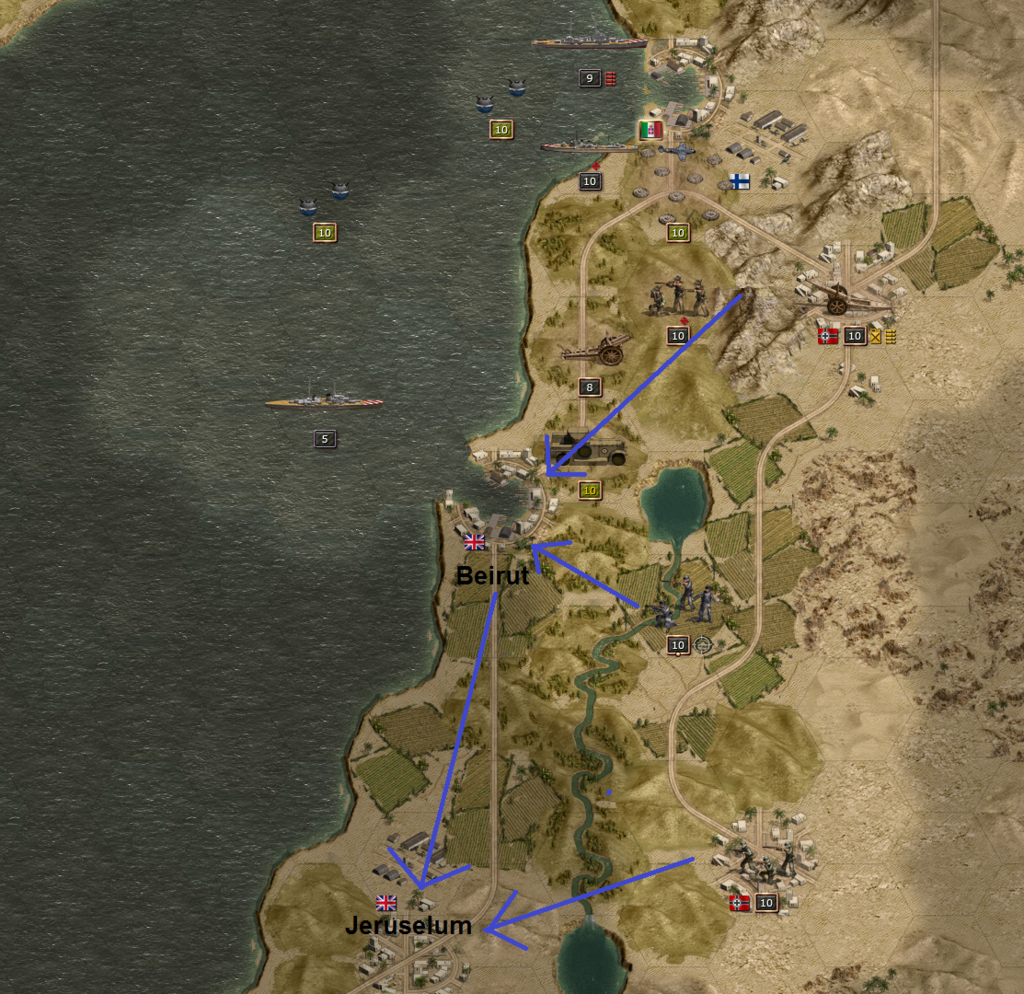
Whilst we have significant ground attack aircraft in the area ready to interdict the Russian armour, the poor weather results in all planes being grounded. Once the weather clears, the Russians will face the full force of the Luftwaffe. In the interim, 2 Panther divisions are being transferred from army group south in an effort to assist in stabilizing the situation.

The Russian winter attack falls on Army Group North. An orderly retreat is performed south of Smolensk whilst reinforcements rush to the area. The city of Smolensk may also need to be abandoned, although it is difficult to extract our garrison safely.
Our desert forces faced considerable opposition in our assault on the city and adjacent oilfield of Basra. The British, supported by a battleship and aircraft carrier, strongly resisted the initial assault from the north east by our Pioniere division, backed by artillery. It was only when we had brought up armour and infantry in the south east and attacked the city on 2 sides, that we were successful in reducing the British defences. With the 2nd oilfield of the Middle East finally captured, we finally have a sufficient supply of oil to operate all capital ships of the Regia Marina whilst also providing an additional source of income.

The strong defences around Basra and the port of Umm Qasr prove stronger than expected, but can do no more than delay the capture of the oilfield
The time taken to capture the oilfields was significantly longer than originally envisaged, due both to the strength of the defenders and poor staff planning. With an Allied amphibious assault in France expected to occur in the summer of ’44 (only 6 months away), we have therefore determined to no longer attempt an assault on the Russian oilfields. Instead, our desert force will focus on mopping up remaining British resistance before performing a final assault on Egypt. This will leave the entire Middle East and North Africa in our hands and will allow us to transfer the majority of our forces to Europe to assist in the defence of liberated territories.

Our forces push north but intend to stop once we reach the Russian border. A skeleton force will be left to man the border, as we don’t expect any significant Russian attacks on this front.
After seeing off sporadic attacks up the Syrian coast, which contributed to our delay in capturing the oilfields, our forces in the area have now adopted an offensive posture and commenced advancing down the Syrian coast. Only Beirut and Jerusalem remain occupied, but will soon be liberated by our forces. Once Jerusalem is captured, we will probe the Egyptian defenses, but will wait until reinforcements arrive from Basra before performing the main assault to drive Commonwealth forces out of North Africa once and for all.









